× × ×
× × ×
12.2018
Last time we read the Ngugi’s text on Performance space and the review on Talal Asad’s “Suicide Bombing”. However, the discussion became broad and subtractive. This time we continue the same topic but with a look through history to compare and contrast both Left and Right perspectives in terms of economy the idea of legality and criminality in revolutionary movements.
The theme of the next series of the reading group is “crime and criminalization (by power) and its relationship to art and its collective and communal aspects”. The reading list will focus on the differences between individualism and collectivism. It also reviews the similarities between the operation of artists collectives (culturally, economically and politically) and illegal communities or criminal collectives antagonistic to the hegemonic powers. In an individual level, the position of the artist in contrast to the state is similar to a powerless criminal. As Ngũgĩ wa Thiong’o mentioned: “The state has its areas of performance; so has the artist. While the state performs power, the power of the artist is solely in the performance.”
Art has been taking for granted as a privileged device to promote social collectivism and cultural prosperity through imagination and its exceptionalism of anti-market production. Yet this aspect of art has some crucial similarities to the collective and communal idea of organized crime and/or criminalized humans by ideological state apparatuses. At the same time, the fancy and luxurious international zone of the art world with its numerous museums, institutions and biennials are sponsored and often used by big corporations for practicing liberalism, manufacturing consent and sometimes money laundry (Beretta family, Charles Saatchi, Sotheby’s and Christie, etc.)
Within this domain, the differences between “class” and “privilege” become crucial. As Chin-tao Wu research showed in his 2007 “Biennials Without Borders?”, Globalization in the art world is another fancy name for westernization. Malcolm X said in an interview: “Every oppressed people, no matter how neat and humble they are, after you drive them so far, they are going to strike back!” Throughout modern history, there have been always certain artists and artist groups who were -directly or indirectly- criminalized, censored or prohibit by supporting a movement or simply belonging to a certain socioeconomic group. This relationship is in contrast to a social, economical or political power (institutions, corporations, state, the majority, etc.) We will examine the role of art in our controlled political ecosystem with its excessive surveillance and securitization.
“The postcolonial state exhibits similar sensitivities. The collective expression of joy and even grief outside the watchful eyes of the state may, in some instances, constitute a crime. So the postcolonial state tries to enact limitations similar to those of the colonial state. So exile is a way of moving the writer from a territorial confinement, where her acts of resistance might ignite other fields, into a global “exclosure.” -Ngũgĩ wa Thiong’o
“In 2001, a few weeks after the 9/11 terrorist attacks, the Whitney Museum of American Art, which was holding its Biennial exhibition of contemporary and cutting-edge art, got a phone call from an unlikely source. An FBI agent was interested in a drawing in the exhibition by the late conceptual artist Mark Lombardi, who had committed suicide the year before. The agent asked to see the drawing, and to obtain a copy of it for the investigation into the attacks.” (Link) Following 9/11, the US government funded two important books about this important event, “9/11 Commission Report” and “Encyclopedia of Terrorism -published by Facts On File”. In contrast to these publications, Verso published a book entirely made from speeches and letters of Osama bin, edited by Bruce B. Lawrence. Simoiultaunously, Patricia Goldstone wrote about Lombardi exposing Harken Energy, Arbusto Energy, BCCI, First American bank, the Bush dynasty and their close financial connection to American, Europan and middle eastern terrorist organizations, money laundry, and illegal banking.
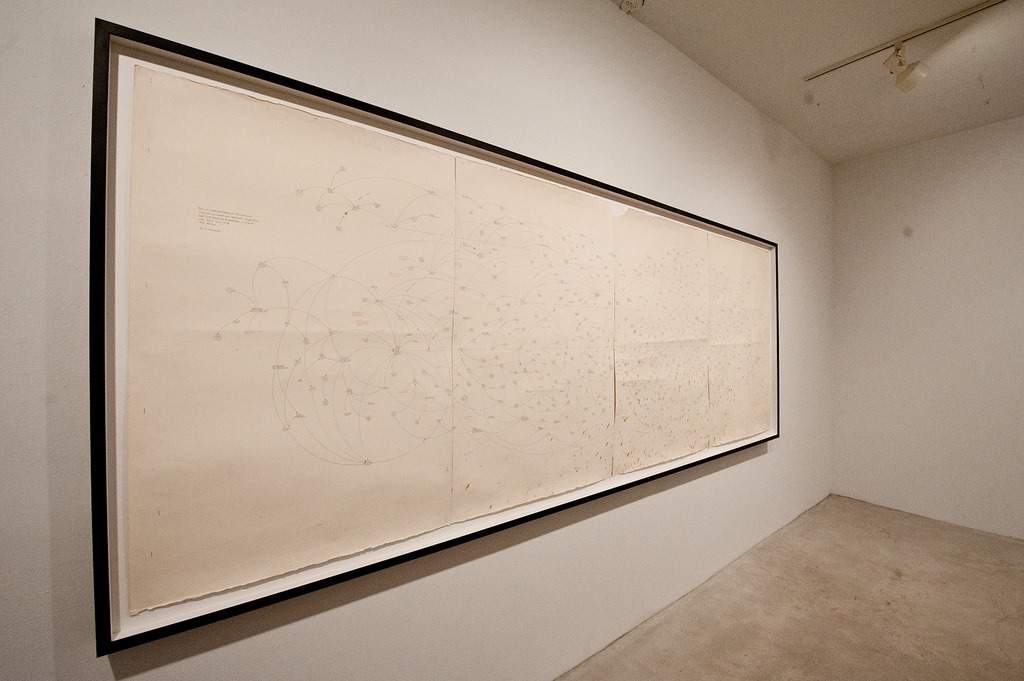
Bulk Reading List
**Individualism / Collectivism**
BOOKS:
Friedrich A. Hayek, The Road to Serfdom
Nicolas Bourriaud, Postproduction
ESSAYS:
Kraevskaia Natalia, Collectivism and Individualism in Society and Art after Doi Moi
Marc Champagne and Mimi Reisel Gladstein, Beauvoir and Rand, Asphyxiating People, Having Sex, and Pursuing a Career
Okwui Enwezor, The Artist as Producer in Times of Crisis
Walter Block, Ayn Rand and Austrian Economics: Two Peas in a Pod
Delio Vasquez, Intercommunalism: The Late Theorizations of Huey P. Newton, ‘Chief Theoretician’ of the Black Panther Party
James H. Cone, The Black Church and Marxism
///
**Crime and Illegalization**
BOOKS:
اﻟﻤﻗﺩﻤﻪ. ﻋﺒﺩ اﺭﺤﻤن ﺒن ﻤﺤﻤﺩ اﺑن ﺨﻠﺪﻮن. Abd Ar Rahman bin Muhammed ibn Khaldun – Muqaddimah
Mahmood Mamdani, Good Muslim, Bad Muslim: America, the Cold War, and the Roots of Terror
Jean Baudrillard, The Spirit of Terrorism and Other essays
Jasbir K. Puar Terrorist Assemblages: Homonationalism in Queer Times
Noam Chomsky and Andre Vltchek – On Western Terrorism From Hiroshima to Drone Warfare
Talal Asad, On Suicide Bombing
Leila Ahmed, Women and Gender in Islam: Historical Roots of a Modern Debate
Jay Day, Corrections and Collections: Architectures for Art and Crime 1st Edition
ESSAYS:
Guillermo G”mez-Peka, The Artist as Criminal
Ngũgĩ wa Thiong’o, Enactments of Power: The Politics of Performance Space
Srinivas Aravamudan, Perpetual War
Paula M. Cooey, Review of “On Suicide Bombing by Talal Asad”
Dalia Said Mostafa, Reflections on Trauma and Memory in Youssef Chahine’s Films / نيهاش فسوي دنع ةمدصلاو ةركاذلا لوح تالمأت
Anne-Marie McManus, Sentimental Terror Narratives: Gendering Violence, Dividing Sympathy
Mahmood Mamdani, Good Muslim, Bad Muslim: A Political Perspective on Culture and Terrorism
Mahmood Mamdani, Reading Ibn Khaldun in Kampala
Fred Moten, The Case of Blackness
Talal Asad, Europe Against Islam: Islam In Europe
Yasser Arafat Payne Æ Hanaa A. Hamdi, ‘Street Love’’: How Street Life Oriented U. S. Born African Men Frame Giving Back to One Another and the Local Community
Reading materials:
- David Castriota, feminizing the barbarian and barbarizing the feminine
- Erik De Vries, Alexandre Kojeve-Carl Schmitt Correspondence and
Alexandre Kojeve, “Colonialism from a European Perspective”
Supplementary Readings:
Link to Download texts (Changing each time)
Date: Sunday 16.12.2018 @18:00
Address: KuvaTaideAkatemia student union space,
–––

Documentation of David Hammons’ 1981 performance “Shoe Tree,” Tribeca, New York City (shown: Richard Serra’s sculpture, T.W.U.). Photo by Dawoud Bey.
× × ×
× × ×
11.2018 #1
The theme of the next series of the reading group is “crime and criminalization (by power) and its relationship to art and its collective and communal aspects”. The reading list will focus on the differences between individualism and collectivism. It also reviews the similarities between the operation of artists collectives (culturally, economically and politically) and illegal communities or criminal collectives antagonistic to the hegemonic powers. In an individual level, the position of the artist in contrast to the state is similar to a powerless criminal. As Ngũgĩ wa Thiong’o mentioned: “The state has its areas of performance; so has the artist. While the state performs power, the power of the artist is solely in the performance.”
Art has been taking for granted as a privileged device to promote social collectivism and cultural prosperity through imagination and its exceptionalism of anti-market production. Yet this aspect of art has some crucial similarities to the collective and communal idea of organized crime and/or criminalized humans by ideological state apparatuses. At the same time, the fancy and luxurious international zone of the art world with its numerous museums, institutions and biennials are sponsored and often used by big corporations for practicing liberalism, manufacturing consent and sometimes money laundry (Beretta family, Charles Saatchi, Sotheby’s and Christie, etc.)
Within this domain, the differences between “class” and “privilege” become crucial. As Chin-tao Wu research showed in his 2007 “Biennials Without Borders?”, Globalization in the art world is another fancy name for westernization. Malcolm X said in an interview: “Every oppressed people, no matter how neat and humble they are, after you drive them so far, they are going to strike back!” Throughout modern history, there have been always certain artists and artist groups who were -directly or indirectly- criminalized, censored or prohibit by supporting a movement or simply belonging to a certain socioeconomic group. This relationship is in contrast to a social, economical or political power (institutions, corporations, state, the majority, etc.) We will examine the role of art in our controlled political ecosystem with its excessive surveillance and securitization.
“The postcolonial state exhibits similar sensitivities. The collective expression of joy and even grief outside the watchful eyes of the state may, in some instances, constitute a crime. So the postcolonial state tries to enact limitations similar to those of the colonial state. So exile is a way of moving the writer from a territorial confinement, where her acts of resistance might ignite other fields, into a global “exclosure.” -Ngũgĩ wa Thiong’o
“In 2001, a few weeks after the 9/11 terrorist attacks, the Whitney Museum of American Art, which was holding its Biennial exhibition of contemporary and cutting edge art, got a phone call from an unlikely source. An FBI agent was interested in a drawing in the exhibition by the late conceptual artist Mark Lombardi, who had committed suicide the year before. The agent asked to see the drawing, and to obtain a copy of it for the investigation into the attacks.” (Link) Following 9/11, the US government funded two important books about this important event, “9/11 Commission Report” and “Encyclopedia of Terrorism -published by Facts On File”. In contrast to these publications, Verso published a book entirely made from speeches and letters of Osama bin, edited by Bruce B. Lawrence. Simoiultaunously, Patricia Goldstone wrote about Lombardi exposing Harken Energy, Arbusto Energy, BCCI, First American bank, the Bush dynasty and their close financial connection to American, Europan and middle eastern terrorist organizations, money laundry, and illegal banking.

Reading List
**Individualism / Collectivism**
BOOKS:
Friedrich A. Hayek, The Road to Serfdom
Nicolas Bourriaud, Postproduction
ESSAYS:
Kraevskaia Natalia, Collectivism and Individualism in Society and Art after Doi Moi
Marc Champagne and Mimi Reisel Gladstein, Beauvoir and Rand, Asphyxiating People, Having Sex, and Pursuing a Career
Okwui Enwezor, The Artist as Producer in Times of Crisis
Walter Block, Ayn Rand and Austrian Economics: Two Peas in a Pod
Delio Vasquez, Intercommunalism: The Late Theorizations of Huey P. Newton, ‘Chief Theoretician’ of the Black Panther Party
James H. Cone, The Black Church and Marxism
///
**Crime and Illegalization**
BOOKS:
اﻟﻤﻗﺩﻤﻪ. ﻋﺒﺩ اﺭﺤﻤن ﺒن ﻤﺤﻤﺩ اﺑن ﺨﻠﺪﻮن. Abd Ar Rahman bin Muhammed ibn Khaldun – Muqaddimah
Mahmood Mamdani, Good Muslim, Bad Muslim: America, the Cold War, and the Roots of Terror
Jean Baudrillard, The Spirit of Terrorism and Other essays
Jasbir K. Puar Terrorist Assemblages: Homonationalism in Queer Times
Noam Chomsky and Andre Vltchek – On Western Terrorism From Hiroshima to Drone Warfare
Talal Asad, On Suicide Bombing
Leila Ahmed, Women and Gender in Islam: Historical Roots of a Modern Debate
ESSAYS:
Guillermo G”mez-Peka, The Artist as Criminal
Ngũgĩ wa Thiong’o, Enactments of Power: The Politics of Performance Space
Srinivas Aravamudan, Perpetual War
Paula M. Cooey, Review of “On Suicide Bombing by Talal Asad”
Dalia Said Mostafa, Reflections on Trauma and Memory in Youssef Chahine’s Films / نيهاش فسوي دنع ةمدصلاو ةركاذلا لوح تالمأت
Anne-Marie McManus, Sentimental Terror Narratives: Gendering Violence, Dividing Sympathy
Mahmood Mamdani, Good Muslim, Bad Muslim: A Political Perspective on Culture and Terrorism
Mahmood Mamdani, Reading Ibn Khaldun in Kampala
Fred Moten, The Case of Blackness
Talal Asad, Europe Against Islam: Islam In Europe
Yasser Arafat Payne Æ Hanaa A. Hamdi, ‘Street Love’’: How Street Life Oriented U. S. Born African Men Frame Giving Back to One Another and the Local Community
Reading materials:
- Ngũgĩ wa Thiong’o, Enactments of Power: The Politics of Performance Space
- Guillermo G”mez-Peka, The Artist as Criminal
- Paula M. Cooey, Review of “On Suicide Bombing by Talal Asad”
Supplementary Readings:
- Okwui Enwezor, The Artist as Producer in Times of Crisis
Link to Download texts (Changing each time)
Date: Sunday 11.11.2018 @17:00
Address: Ex-club (Merimiehenkatu 36, 00150 Helsinki)
–––

Documentation of Hammons’ 1981 performance “Shoe Tree,” Tribeca, New York City (shown: Richard Serra’s sculpture, T.W.U.). Photo by Dawoud Bey.
× × ×
× × ×
09.2018 #1
In the last meeting, we read the second part of Edward Said’s Culture and Imperialism.
The next reading group meeting will be simultaneous with Shahram Khosravi’s talk in Helsinki. Shahram Khosravi is Professor of Social Anthropology at Stockholm University and the author of the books: Young and Defiant in Tehran, University of Pennsylvania Press (2008); The Illegal Traveler: an auto-ethnography of borders, Palgrave (2010); and After Deportation: Ethnographic Perspectives, Palgrave (2017, edited volume). He has been an active writer in the Swedish press and has also written fiction.
Khosravi will join our reading group before the public talk, the conversation will be facilitated by Arash Akhlaghi.
In Race, Nation, Class Balibar ends with a paragraph on racism and crisis of democracy:
These tendencies not only form part of the conditions leading to a worsening of the crisis, they contribute to every question of social rights and civil rights being perverted into a question of privileges that have to be protected or reserved for certain ‘natural’ beneficiaries. Rights are exercised in reality. Privileges may, in large part, be imaginary (indeed this is why they can generally be conferred upon exploited classes). Rights grow of themselves qualitatively through the extension of the number (and power) of those who enjoy and claim them. Privileges can only be guaranteed by the defence of an exclusiveness that is as restrictive as possible. It seems to me that we can in this way better understand why the crisis conjuncture combines within the popular classes an uncertainty (which at times leads to panic) as to the ‘security’ of existence and an uncertainty about collective ‘identity’. The formation of the immigration complex I spoke of above is both a cause and an effect of that uncertainty, and the same is true of the tendential dissolution of the organized working class, around which a political tradition had formed which expressed the defence of economic and social interests in the language of rights and not in that of privileges. These two phenomena fuel one another. When they become politically inextricable, we have before us both a racist crisis and a crisis racism.
As a Marxist theoretician and intellectual Balibar is challenging the economism of orthodox Marxists in regards to the issue of racism and nationalism. Balibar is criticizing both Wallerstein’s rigid economism and the notion of ‘privilege’. In contrast to Balibar who is examining racism while being exterior to it, Shahram Khosravi is examining the same issue from the perspective of the subject and analysis how does it feel to be a crisis?
Reading materials:
- Fred Moten; The Undercommons: Fugitive Planning & Black Study (Intro)
Supplementary Readings:
- Shahram Khosravi, The ‘illegal’ traveler: an auto-ethnography of borders
Link to Download texts (Changing each time)
links:
- Thinking through Racisms conversation: Haus der Kulturen der Welt
- The rehabilitation of ‘human nature’, or, where did anthropology go?
- Book: Maurice Bloch: In and Out of Each Other’s Bodies: Theory of Mind, Evolution, Truth, and the Nature of the Social
- Book: Étienne Balibar, Immanuel Wallerstein: Race, Nation, Class: Ambiguous Identities
Announcements:
Date: Tuesday 04.09.2018 @15:00
Address: Exhibition Laboratory (Merimiehenkatu 36, 00150 Helsinki)
–––
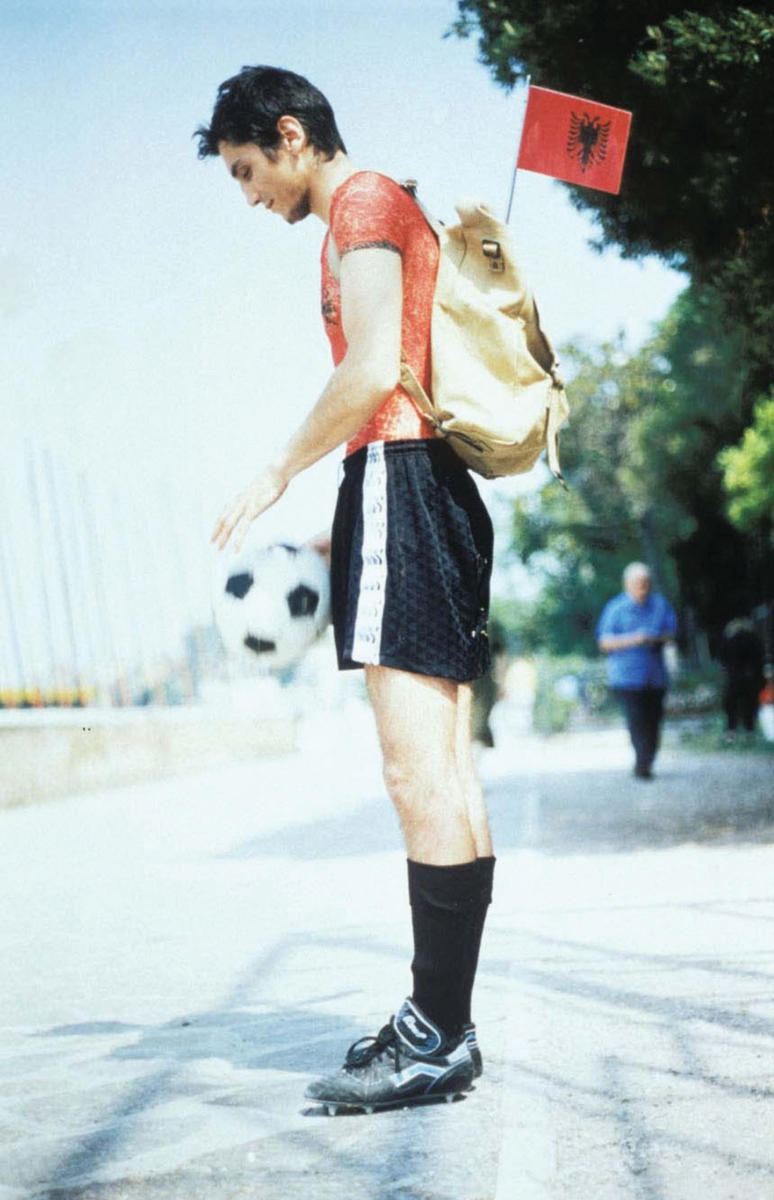
The Sislej Xhafa, Padiglione Clandestino, 1997. Stealth performance. (From Bidoun)
× × ×
× × ×
08.2018 #1
In the last meeting, we read the first part of Edward Said’s Culture and Imperialism.
For the next reading, we will review the second chapter of Edward Said’s Culture and Imperialism. Published in 1994, many years after his iconic work Orientalism, the book examines the intersections of culture (art, literature, films, etc.) and Empire. This reading will be a precursor for reading Shahram Khosravi’s talk in Helsinki.
Reading materials:
- Edward W. Said, Culture and Imperialism (Chapter 2)
- Ibn Warraq, Defending the West: A Critique of Edward Said’s Orientalism
Supplementary Readings:
- Edward Said’s Culture and Imperialism: A Symposium (Bruce Robbins; Mary Louise Pratt; Jonathan Arac; R. Radhakrishnan; Edward Said)
- Shahram Khosravi, The ‘illegal’ traveler: an auto-ethnography of borders
Link to Download texts (Changing each time)
links:
- Thinking through Racisms conversation: Haus der Kulturen der Welt
- Maryam Monalisa Gharavi – Face/Less: Human, Inhuman, Abhuman
Announcements:
- Ravelling Enunciations // Timothy Jude Smith at Third Space
- Bahadori / Holmström / Hyrri / Majander / Meriläinen at Galleria Lapinlahti
- Public talk by Shahram Khosravi: How Does it Feel to be a Crisis?
Date: Friday 17.08.2018, at 14:00
Address: Pyhän Birgitan puisto (call hami if you can’t find +358417537605)
–––
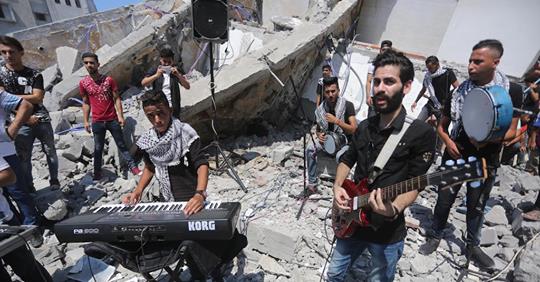
The Palestinian band Al-Anqaa play in the ruins of the cultural centre (MEE/Mohammed Asad) (link)
07.2018 #1
In the last meeting (which took place in Shelter / Suoja / Убежище Festival), we read the second part of Jason Bahbak Mohaghegh‘s book on Eastern Postmodernism along Foucault’s Security, Territory and Population. The conversation was focused on insurgency, counter-insurgency and history of art in relation to artistic movements and methodologies. We discussed feminist strategies in relation to historic revolutionary and evolutionary (waves) moments. Regarding the same topic, we talked about Hito Steyerl’s artworks and writings of Sara Ahmed.
For the next reading, we will review the first chapter of Edward Said’s Culture and Imperialism. Published in 1994, many years after his iconic work Orientalism, the book examines the intersections of culture (art, literature, films, etc.) and empire. This reading will be a precursor for reading Hamid Dabashi’s Brown Skin, White Masks and Sherene Razack’s Casting Out: The Eviction of Muslims from Western Law and Politics.
The next reading group will take place at Shipwreck Information Center exhibition in Turku’s Brinkkala gallery.
Reading materials:
- Edward W. Said, Culture and Imperialism (introduction + Chapter 1)
Supplementary Readings:
- Edward Said’s Culture and Imperialism: A Symposium (Bruce Robbins; Mary Louise Pratt; Jonathan Arac; R. Radhakrishnan; Edward Said)
- Shahram Khosravi, The ‘illegal’ traveler: an auto-ethnography of borders
Link to Download texts (Changing each time)
links:
- Thinking through Racisms conversation: Haus der Kulturen der Welt
- Maryam Monalisa Gharavi – Face/Less: Human, Inhuman, Abhuman
Announcements:
Date: Saturday 14.07.2018, 18:00
Address: Shipwreck Information Center @Turku Brinkkala Gallery
–––

Cyprus, 2015 by Rayyane Tabet, (photo from Sharje Foundation)
06.2018 #1
Last month, we looked at how ‘borderless’ ecological systems – water and climate – directly influence conflict and humanitarian crises. Linda Ciesielski facilitated the conversation around the urgent environmental issues of our age reflecting on a film by Jennifer Baichwal, documentary filmmaker, and photographer Edward Burtynsky titled Watermark (2013). We discussed land rights, territoriality, the sovereignty of indigenous peoples and role of states in protecting natural resources from corporations. Afterward, we touched on the issue of global aid based on location, culture, and privilege in regard to affirmative methodologies.
In last reading (which took place in Helsinki Airport) we read the first part of Jason Bahbak Mohaghegh’s book on Eastern Postmodernism. The conversation was focused on insurgency, counter-insurgency and history of art in relation to historic and contemporary geopolitical situation of the east.
From the cover:
The insurgent, the poet, the mystic, the sectarian: these are four modes of subjectivity that have emerged amid Middle Eastern thought’s attempt to reverse, dethrone, or supersede modernity. Providing a theoretical overview of each of these existential stances, Jason Bahbak Mohaghegh engages the views of thinkers and artists of the last several decades, primarily from Iran, but also from Arab, Turkish, North African, Armenian, Afghani, Chechen, and Kurdish backgrounds. He explores various dimensions of the Middle Eastern experience at the threshold of the postmodern moment, including revolutionary ideology, avant-garde literature, new-wave cinema, and radical-extremist thought. The profound reinvention of concepts characteristic of such work—fatalism, insurrection, disappearance, siege—provide unique interpretations and confrontations with the modern period and its relationship to those who presumably fall outside its boundaries of self-consciousness. Expanding the conversation, Mohaghegh contrasts the impressions of the Middle Eastern figures considered with those of the most incisive Western thinkers of modernity, such as Nietzsche, Heidegger, and Baudrillard, to offer an original global vision that crosses the East-West divide.
Shelter / Suoja / Убежище: 3-day international annual festival-laboratory running in the space of a real bunker. We invited artists, musicians, performers and lectors to comprehend the “shelter” in all its hypostases, forms and manifestations. 3 days/ 47 participants/ 1 shelter
Reading materials:
- Jason Bahbak Mohaghegh: “Insurgent, Poet, Mystic, Sectarian: The Four Masks of an Eastern Postmodernism” (Chapter 5: Vision, Disappearance, and the Soundscape New-Wave Iranian Cinema and the Postmodern Pack)
- Michel Foucault, “Security, Territory, Population” (Part three – 25 January 1978)
Supplementary Readings:
- (UN)WALL /// Exodus or the Voluntary Prisoners of Architecture
- Exodus, or the voluntary prisoners of architecture
Link to Download texts (Changing each time)
Announcements:
Shelter / Suoja / Убежище: Finnish-Russian experimental poetry/music/art festival. Poetry, discussions, rap music, noise, experimental music, media-art, performance. Invited artists, poets and musicians from Russia and Finland
Memory Theatre | Judit Schuller
Date: Sunday 03.06.2018, 15:00
Address: Shelter Festival, @Vapaan Taiteen Tila · Vilhonvuorenkuja 15-16, 00500 Helsinki (Space for free Arts)
–––
× × ×
× × ×
04.2018 #1
Last week, we looked at how ‘borderless’ ecological systems – water and climate – directly influence conflict and humanitarian crises. Linda Ciesielski facilitated the conversation around the urgent environmental issues of our age reflecting on a film by Jennifer Baichwal, documentary filmmaker, and photographer Edward Burtynsky titled Watermark (2013). We discussed land rights, territoriality, the sovereignty of indigenous peoples and role of states in protecting natural resources from corporations. Afterward, we touched on the issue of global aid based on location, culture, and privilege in regard to affirmative methodologies.
This week we will read a text by Jason Bahbak Mohaghegh on Eastern Postmodernism.
From the cover:
The insurgent, the poet, the mystic, the sectarian: these are four modes of subjectivity that have emerged amid Middle Eastern thought’s attempt to reverse, dethrone, or supersede modernity. Providing a theoretical overview of each of these existential stances, Jason Bahbak Mohaghegh engages the views of thinkers and artists of the last several decades, primarily from Iran, but also from Arab, Turkish, North African, Armenian, Afghani, Chechen, and Kurdish backgrounds. He explores various dimensions of the Middle Eastern experience at the threshold of the postmodern moment, including revolutionary ideology, avant-garde literature, new-wave cinema, and radical-extremist thought. The profound reinvention of concepts characteristic of such work—fatalism, insurrection, disappearance, siege—provide unique interpretations and confrontations with the modern period and its relationship to those who presumably fall outside its boundaries of self-consciousness. Expanding the conversation, Mohaghegh contrasts the impressions of the Middle Eastern figures considered with those of the most incisive Western thinkers of modernity, such as Nietzsche, Heidegger, and Baudrillard, to offer an original global vision that crosses the East-West divide.
Reading materials:
- Jason Bahbak Mohaghegh: “Insurgent, Poet, Mystic, Sectarian: The Four Masks of an Eastern Postmodernism” (Chapter 1: Insurgent: 1. Theorizing the Insurgent: Otherless Subjectivity, Radical Coldness, and the East-West Matrix + 2. Images of Resistance: Media, Modernity, and the Machine Within Iranian Revolutionary Ideology)
- Michel Foucault, “Security, Territory, Population” (18 January 1978)
Link to Download texts (Changing each time)
Announcements:
Going Back to Materiality Exhibition, Eloy Cruz del Prado and Jessica Escobar Suárez
Red May Opening, Helsinki, Alkovi Gallery (29.05.2018 @16:00)
Date: Sunday 15.04.2018, 18:00 – 20:00
Address: Helsinki Airport – Call 0417537605 if you get lost
–––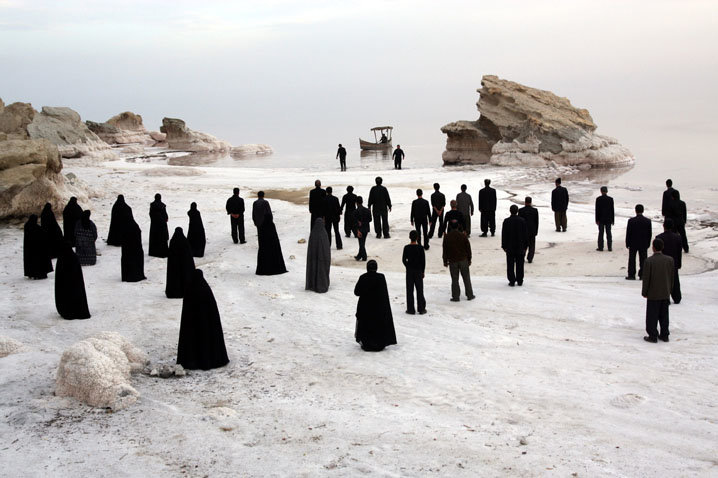
Photo: The White Meadows, directed by Mohammad Rasoulof and edited by Jafar Panahi.
× × ×
× × ×
03.2018 #2
Following previous discussions on borders and immigration (through Foucault and Vrilio), we look at how ‘borderless’ ecological systems – water and climate – directly influence conflict and humanitarian crises. The root of many “failed states” reported in the news, including Syria, Sudan, Somalia, is struggle over water. Water conflicts extend to Finland, with recent controversial proposals to bottle water in Sámi lands and privatize water.
With societal water conflicts on a global and local level, what is the role of artist in these issues and this discourse?
How are contemporary artists participating in the politics and social issues surrounding water?
We will watch part of a short film: Watermark (2013) by Jennifer Baichwal, documentary filmmaker, and photographer Edward Burtynsky followed by a discussion of the readings facilitated by Linda Ciesielski.
Linda Ciesielski is a student at KuvAtaideakatema, and is interested in art that creates dialogue between people and place. Previously, she has worked in urban forestry, climate change planning, water resource management, and design firms. She holds a Bachelor of Science in Landscape Architecture from Cornell University, and a Master of City Planning from MIT.
Background information on contemporary water conflicts:
Gleick, P.H. “Water, Drought, Climate Change, and Conflict in Syria.” Weather, Climate and Society. Vol 6. 2016.
Vidal, John. “Water supply key to outcome of conflicts in Iraq and Syria, experts warn.” The Guardian. July 2, 2014
Sámi land and water rights. Universal Periodic Review (UN Human Rights Council). May 2017.
Sámi bottled water controversy: YLE Sampi. “Sacred spring or source of money? Controversy over water bottling plant in northern Finland.” January 2018.
Interactive map of world water conflicts (with details and dates):
http://www2.worldwater.org/conflict/map/
Artists at the intersection of politics and water:
The Politics of Water and Contemporary Art, article from exhibit in Seoul, Korea of 40 artists (2015) Artists at the exhibit
Hydrologies of Transformation: Capitalism, Hegemony, and the Meanings of Water. Simon Fraser University. Upcoming lecture. April 2018.
Documentary Films on water and conflict.
Link to Download texts (Changing each time)
Date: Wednesday 28.03.2018, 18:00 – 20:00
Address: Ex-club (Merimiehenkatu 36)- Call 0417537605 if you get lost
–––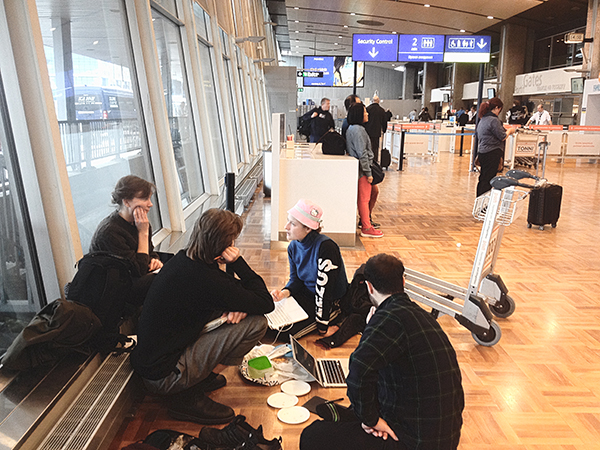
Photo: Reading group at Helsinki International Airport
× × ×
× × ×
03.2018 #1
Last reading focused on the complications of the paradox of safety, and organized or governmental security, intelligence and surveillance. For the next meeting, we will go over the general features of security apparatuses through Foucault’s 1978 Lectures on “Security, Territory, Population“ lectures at the Collège de France. These lectures are a continuation of the previous year’s lecture titled “Society Must Be Defended” (1975–1976) which contains an explanation of the term “Civil war” in the form of rigorous treatment of a working definition. Foucault goes into great detail how power (as Foucault saw it) becomes a battleground drifting from civil war to generalized pacification of the individual and particularly the systems he (the individual) relies upon and gives loyalty too: “According to this hypothesis, the role of political power is perpetually to use a sort of silent war to re-inscribe that relationship of force, and to re-inscribe it in institutions, economic inequalities, language, and even the bodies of individuals.” Foucault begins to explain that this generalized form of power is not only rooted in Disciplinary institutions but is also concentrated in “political sovereignty, the military, and war,” so it is, in turn, spread evenly throughout modern society as a network of domination.
We will Read Paul Virilio’s Administration of Fear alongside Cynthia Wright’s “History, Memory and Immigration Controls”. As supplementary text we read “Editorial: Why No Borders?” by Bridget Anderson, Nandita Sharma, and Cynthia Wright.
Reading materials:
- Michel Foucault, “Security, Territory, Population” (11 January 1978)
- Cynthia Wright, “History, Memory and Immigration Controls”
Supplementary Reading:
- Bridget Anderson, Nandita Sharma, and Cynthia Wright, “Editorial: Why No Borders?”
- Paul Virilio’s Administration of Fear
Link to Download texts (Changing each time)
Announcements:
Naistenpäivän mielenosoitus/Women’s day demonstration,
Friends without borders st patrick’s special, stand-up & music,
Other/Cinema: Films from the Middle East
Politics and Poiesis in Telematic Participation
Date: Sunday 11.03.2018, 13:00 – 15:00
Address: Helsinki International Airport – Call 0417537605 if you get lost
–––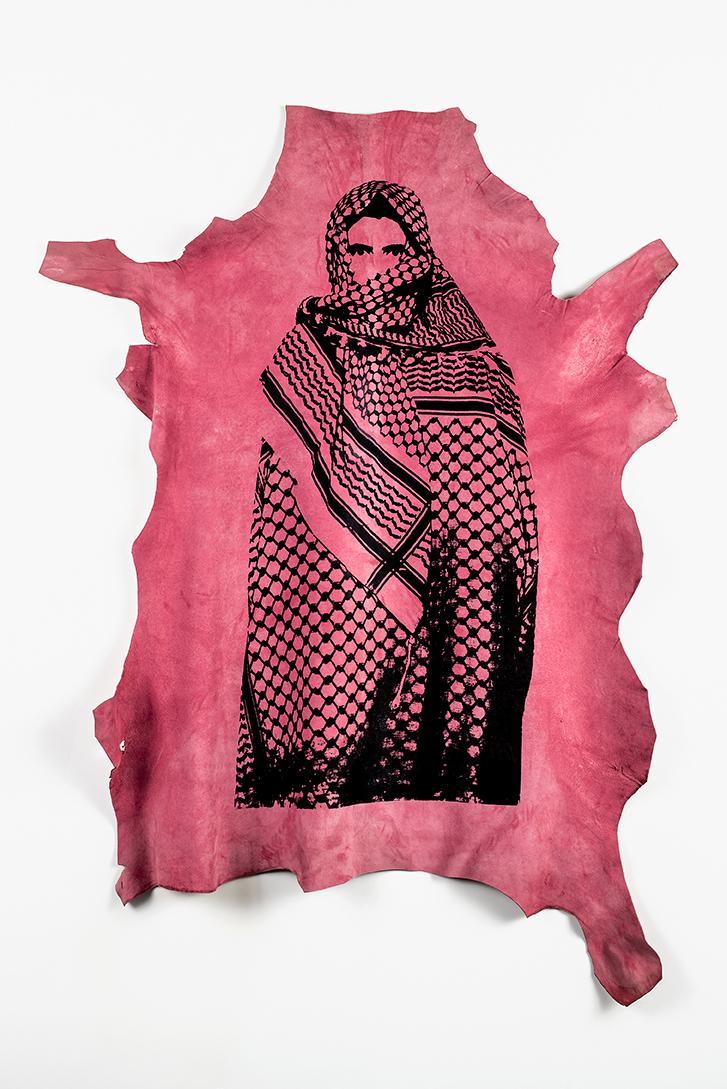
“Cloak,” by Jamil Hellu, Photograph: Jamil Hellu Link
× × ×
× × ×
02.2018 #2
The next reading group will focus on the complications of the paradox of safety, and organized or governmental security, intelligence and surveillance. It is a good time to continue the debate on ‘Necropolitics’, after this week’s incident at Kiasma (Helsinki Contemporary Art Museum), where a group of artists was not allowed to perform due to an unidentified security threat. Link And here is the artists’ collective statement about the event.
In Kiasma’s response to the incident and artist’s protest, (artists who were mostly minority, asylum-seekers and migrants) they showed that they have difficulty in dealing with racism. Responding to these issues requires; an understanding of how racism operates in each particular societal context? what are the implications of lack of representation? How safety and security should be implemented based on representation and privileges? and finally what is the role of an institution in transferring these issues to the public with transparency, for political and educational purposes?
As its commonly known, the term asylum-seeker refers to someone who has fled a certain situation (war, slavery, environmental conflicts, etc.). Safety is embedded in the definition of ‘asylum-seeker’ or ‘refugee’ rather than ‘migrant’. Migration can occur for a verity of reasons, such as economic hardship, hunger, marriage etc. Connecting to last week’s conversation, we talked about sovereignty of the body and state, in relation to Gilles Deleuze’s Postscript on the Societies of Control, and touched on topics such as anxiety and suicide in works of figures such as Georges Bataille, Carl Schmitt, Michel Foucault and Judith Butler.
Announcement:
Pure Party Helsinki 23.02.2018,
Socialize This! with Red May Seattle 22.02.2018,
Schuller Judit Flóra: Memory Theatre Budapest, Hungary 23.02.2018
Reading materials:
- Chantal Mouffe, Artistic Activism and Agonistic Spaces
- Judith Butler, Beside Oneself: On the Limits of Sexual Autonomy
Supplementary Reading:
- Don Mitchell, Against Safety, Against Security: Reinvigorating Urban Life, (Excerpt from: The Right to the City Chapter 9)
- Achille Mbembe, Provisional Notes on the Postcolony
- Capital Vol. I, Part 6: Wages (Chapter 19-22)
Link to Download texts (Changing each time)
Date: Friday 23.02.2018, 18:00 – 20:00
Address: Ex-Club (Merimiehenkatu 36) Call 0417537605 to get in
–––
(Photo: Antero Mentu & Perfo PhiloSuva Suva at Myymälä2 Gallery, Image credit: Sirkku Niskanen)
× × ×
× × ×
02.2018 #1
In 2018, the Reading Group will focus on topics in “Power and Paranoia ⇌ Control and Anxiety” through collective and artistic initiatives such as conversation and dialogue. This reading group will be parallel with the “Airport Reading Group” that is focused on issues of subjectivity, postcolonialism, and border politics.
For the next session, we will read Postscript on the Societies of Control by Gilles Deleuze, in addition to Achille Mbemb’s essay Necropolitics. Necropolitics or Necrocanibal are systematic forms of violence as a way to execute power. In the essay, Mbembe draws on the concept of biopower and explores its relation to notions of sovereignty (imperium) and the state of exception (Carl Schmitt). We pair these text to the first part of the book “Dead Aid” by Dambisa Moyo.
Moyo constructs an interesting case against aid. She argues that the type of aid being channeled to Africa in most cases “fosters dependency” and reproduces similar social and economic problems that the continent has already faced. She refers to economists such as John Maynard Keynes and Harry Dexter White and their vision toward the World Bank, International Monitory Fund (IMF) and what later led to the creation of the General Agreement on Tariffs and Trade and the World Trade Organization. Her argument is not a new one of its kind, as she admits, however its temporality functions as another reminder for forging interventions in different parts of Africa.
Aside from its simple language and comprehensive argument, Dead Aid has also been criticized for not examining inequality within or outside the context of Africa, and for its purely economic lens, without attacking capitalism directly. Although, her argument stands against the neo-liberal and ethical explanations of moral philosophers such as Peter Singer. The ethical utlieriterian views in which aid is one of the only solutions to maximize welfare (and minimize pain) without taking into consideration the economic complexity of today’s politics.
Announcement: Riikka Theresa Innanen has a talk and collective performance related to “Right to Live” in Kiasma on 10.2.2018. (link) Riikka Theresa Innanen is a Finnish choreographer, dancer and visual artist based in Helsinki.
Reading materials:
- Gilles Deleuze, Postscript on the Societies of Control
- Achille Mbembe, Necropolitics
- Dambisa Moyo, Dead Aid (Introduction, Chapter I, II)
Supplementary Reading:
Link to Download texts (Changing each time)
Date: Friday 09.02.2018, 17:00 – 19:30
Address: Myymälä2 Gallery, (Uudenmaankatu 23 F) Call 0417537605 to get in
–––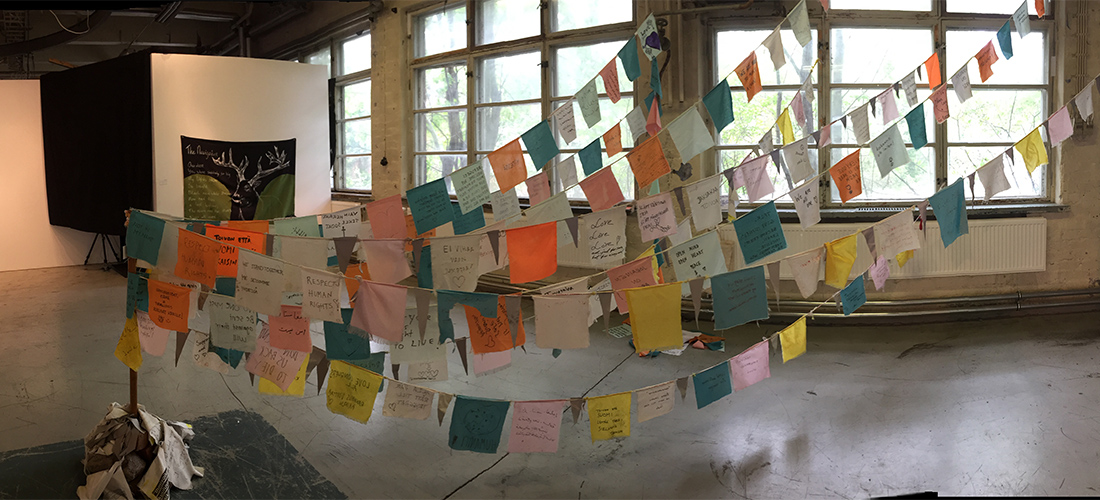
(Photo: Riikka Theresa Innanen)
× × ×
× × ×
01.2018 #1
The first session of 2018 reading group will be dedicated to a presentation by Jo Kjaergaard on her participation in 2017 Bogotá Kuir Festival. The reading group will start with a screening of her video BogotáKuir.
About this project, she writes: “In 2014, I lived in Bogota where I was working as a cleaner and tattoo apprentice. During that time, I became involved in activism with Queer and feminist groups. Last year, In 2017, I participated in the 4th KUIR BOGOTA festival and worked with the organizers and artists in producing some of the events. I would like to use this opportunity and invite artists and activists to a conversation and discuss this subject.”
The Queer KUIR BOGOTA International Art and Film Festival is a gateway to the queer universe from artistic creation, through the crossing of different perspectives. The philosophy of the Festival raises the rupture of hegemonies and patriarchal constructions, reviewing gender binary structures and models of normativity, as well as the understanding of queer reality, beyond the LGBTI, as an act of liberation before a failed system; an area of reflection and creation of community. –kuirbogota.com
–––
In the book, Disidentifications: Queers of Color and the Performance of Politics, José Esteban Muñoz focuses on the term disidentifications, rather than misidentification. For Muñoz, –as Alicia Arrizon writes– the act of writing becomes a “disidentificatory” venture of the self, “whose relation to the social is not over determined by universalizing rhetoric of selfhood. While examining the process of identification/disidentification in performance art, film, pop art, visual culture, porn, ethnography, mass media and literature, among other things, Muñoz insists on a dialectics that describes the relations between theory and practice.“
From introduction:
“The fact that Marga was able to hear the lesbian’s call while her mother tuned out, that she was capable of recognizing the cara being discussed as her own face, contributed, in no small part, to her survival as a lesbian. Disidentification is meant to be descriptive of the survival strategies the minority subject practices in order to negotiate a phobic majoritarian public sphere that continuously elides or punishes the existence of subjects who do not conform to the; phantasm of normative citizenship, In this instance, Marga’s disidentification with these damaged stereotypes recycled them as powerful and seductive sites of self-creation. It was, after all, the wigs that made her want to be one.” –Disidentifications: Queers of Color and the Performance of Politics
Reading materials:
- Joao Nemi Neto, Anthropophagic Queer: A Study on Abjected Bodies and Brazilian Queer Theory (Chapter 1, introduction)
- José Esteban Muñoz, Disidentifications (Introduction)
Supplementary Reading:
- Norma Mogrovejo Aquise, Feminismo en La Era Del Neoliberalismo Hegemonico (In Spanish)
Link to Download texts (Changing each time)
Date: Saturday 20.01.2018, 17:00 – 19:30
Address: Ex-club (Merimiehenkatu 36, 00150) Call 0417537605 to get in
–––
(Photo: Still from BogotáKuir, by Jo Kjaergaard)
× × ×
× × ×
12.2017 #1
The next reading session will be an exercise in preparation for Carlos Salvador’s presentation during the KuvA Research Days, which will happen in ex-club.
Carlos Salvador, a headmaster of an indigenous Wixarika secondary school and a self-learned photographer will be present and oversee the presentation which is organized by Lea Kantonen. The Wixarika have a shamanistic approach to art and the shamans strive towards something they call Nierika (The Gift of Seeing). Carlos Salvador’s artistic work can be described as non-formal education.
We are reading a section from “Art of the Huichol Indians” edited by Lowell John Bean & Sylvia Brakke Vane, published in 1978 by Fine Art Museum of San Fransisco. The piece “Neurochemistry of Religious Insight and Ecstasy” is examining the visual effects of spiritual experience during rituals to the contemporary pharmacological effects of chemistry in human brain or “pure cerebral time-space”.
With contrasting the works of Kurt Lewin, and Jack Kerouac to The Tibetan Book Of The Dead and hallucinogenic effects of Peyote, the writer is making a case for differentiating the practices of Huichol’s medicine man (as somewhere between a shaman-visonariesand priest-practitioners) to the ideal of Buddhism and Tao to the western physician-scientists or that of an ethnographer.
Reading materials:
- Neurochemistry of Religious Insight and Ecstasy, Arnold J. Mandell
- Peter T. Furst, Art Of “Being Huichol”
- Susan Egar & Peter R. Collings, Huichol Women’s Art
Supplementary Reading:
Date: Sunday 10.12.2017, 15:30 – 17:30
Address: Ex-club (Merimiehenkatu 36, 00150) Call 0417537605 to get in
–––
(Photo: Guadalupe, Ramon’s wife, during 1966 peyote pilgrimage, photo by Barbara G. Mayerhoff at The Art of the Huichol Indians book)
× × ×
× × ×
11.2017 #2
In the following session, we will focus on the topic of public art and role of the artist in society. The reading group will be simultaneous with the “As an artist in society” seminar with Irmeli Kokko, Paul O’Neil (Artistic Director of Checkpoint Helsinki), Christine Langinauer and will be moderated by Pontus Kyander (lecturer Academy of Fine Arts).
Focusing on the idea of public art and culture in relation to citizenship and everyday spaces of life, whether urban/rural, we will read a section of Étienne Balibar’s recent book Citizenship. One of the ways in which Balibar problematizes the idea of citizenship is through the notion of inclusion and exclusion of the subjects within the state. Although debates on exclusion are not new and writers such as Rancière, Lok Wacquant, Genevieve Fraisse, and Eva Cherniavsky (which we have read previously) among others, have separately worked on this issue, but Balibar offers a new angle in this perspective. He proposes a positive, ‘affirmative’ agenda when identifying the foremost challenge facing democratic politics today: ‘finding forms of collective autonomy that would correspond to the environment of globalization’.
From the cover jacket:
“Not everyone is a citizen, even within one nation-state. It has been said that certain persons are in society without being of society. The dynamics of inclusion and exclusion continue to generate dramatic asymmetries and create openings and closures, especially today in a time of particular fragility and when national sovereignty is in flux. So are there too many antinomies within citizenship? Balibar does not shy away from these antimonies, but he knows that to renounce citizenship would be to abandon the chance to create new modes of collective autonomy, in short, to democratize democracy.”
Citizenship is constantly being redefined within the public realm for demands of equality and liberty. Artists as culture-producers are able to play a big role in transforming this notion of citizenship and question the preexisting categories of “active citizen”.
We will also read an essay by Paul O’Neil titled Three stages in the art of public participation: the relational, social and durational. In the text, with references on modern, post-modern and contemporary art we get a precise analysis of participatory art and its function in durational works; a perspective that is emphasized as “public time” rather than space.
Reading materials:
- Étienne Balibar, Citizenship (Chapter 3)
- Paul O’Neil, Three stages in the art of public participation (essay)
- Marina De Chiara, A tribe called Europe (essay)
Supplementary Reading:
Date: Tuesday 21.11.2017, 13:00 – 17:00
Address: Ex-club (Merimiehenkatu 36, 00150) Call 0417537605 to get in
–––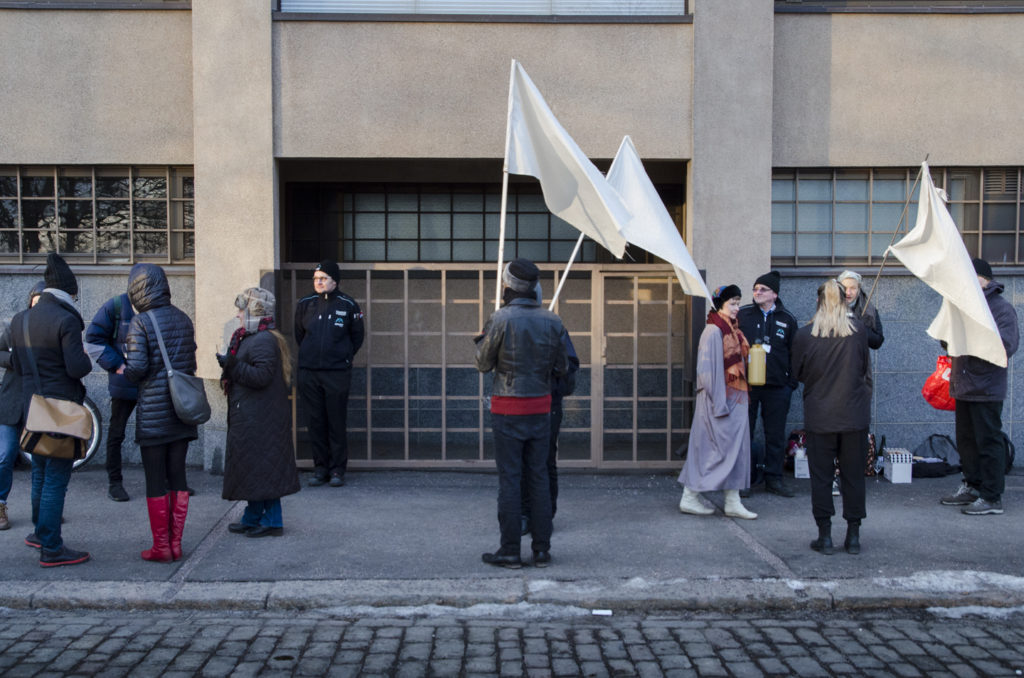
(Photo: Crowd•Source” 2017 Curated by Timo Tuhkanen, at 13lock)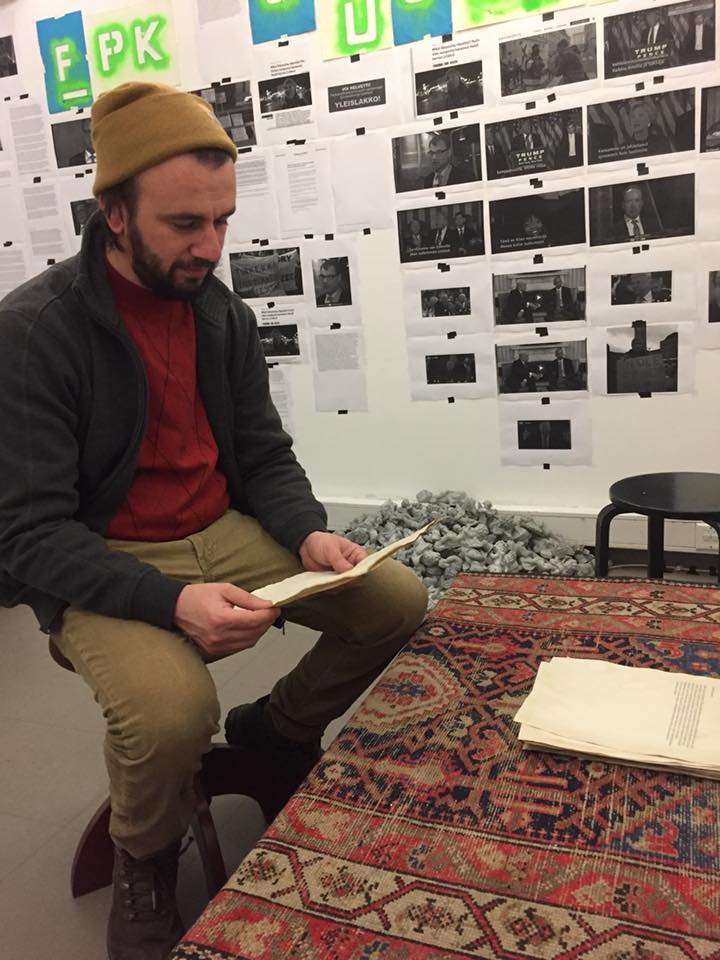
(Photo: Muhaned Durubi reading from ”The Diary of the Last Seeker” On the background “Suomi100/ the broken ones” on 14.11.2017)
× × ×
× × ×
11.2017 #1
The next reading group meeting will be simultaneous with the Become Collective series presentation by Art and Activism and FAR Night School and is followed by an informal conversation and dinner.
In the previous session, Giovanna Esposito Yussif & Christine Langinauer presented their projects and talked about their join initiative Night Schoolers group. After the presentation and talks, we briefly talked about Nomadic agency, archive and untold history and Nomadic life as resistance. During the conversation about post-colonialism and the issues of agency, the Manifesto Antropófago (Cannibalist Manifesto in English) by the Brazilian poet and polemicist Oswald de Andrade was mentioned. The group unanimously agreed about the U.S-centered and Euro-centered academic dominance in terms of distribution and expansion of critical topics. Fred Moten and Stefano Harney’s The University and the Undercommons poetic language on criticizing this relationship with the university was evident.
For the next session, we will focus on intersections of feminism and post-colonial theory, and maybe we touch on their relationship to the role of artists in our contemporary time, which as Okwui Enwezor has mentioned is in permanent state of transition.
“The proper task of a history of thought is: to define the conditions in which human beings ‘problematize’ what they are, what they do, and the world in which they live.”
—Michel Foucault, The History of Sexuality
Along the same topic, Swati Parashar and Aníbal Quijano argued in different ways for this notion of ‘problematizing’ what we know as the production of knowledge in the west versus the rest of the world. Quijano relates this production to the non-western understanding of the totality, while Parashar holds the same production of knowledge in relation to state violence and argues for intersections of feminism and postcolonialism; “Aligning the interests of postcolonialism and feminism, we have tried to map many such erasures in this special issue to understand the cycle of violence and wars within and around postcolonial states. The contributors have reflected on how these two theoretical approaches can be combined to offer a nuanced understanding of the creation of the postcolonial ‘state’ as a political entity and its simultaneous displacement…”. In this process, she uses ideas in Veena Das;
“[Das] sees violence not as an interruption of ordinary life but as something that is implicated in the ordinary. She suggests, like Fanon, that the ‘ordinariness’ of violence is marked by the blurring of boundaries between perpetrator, victim and witness and the shared social space between these entities.”
––
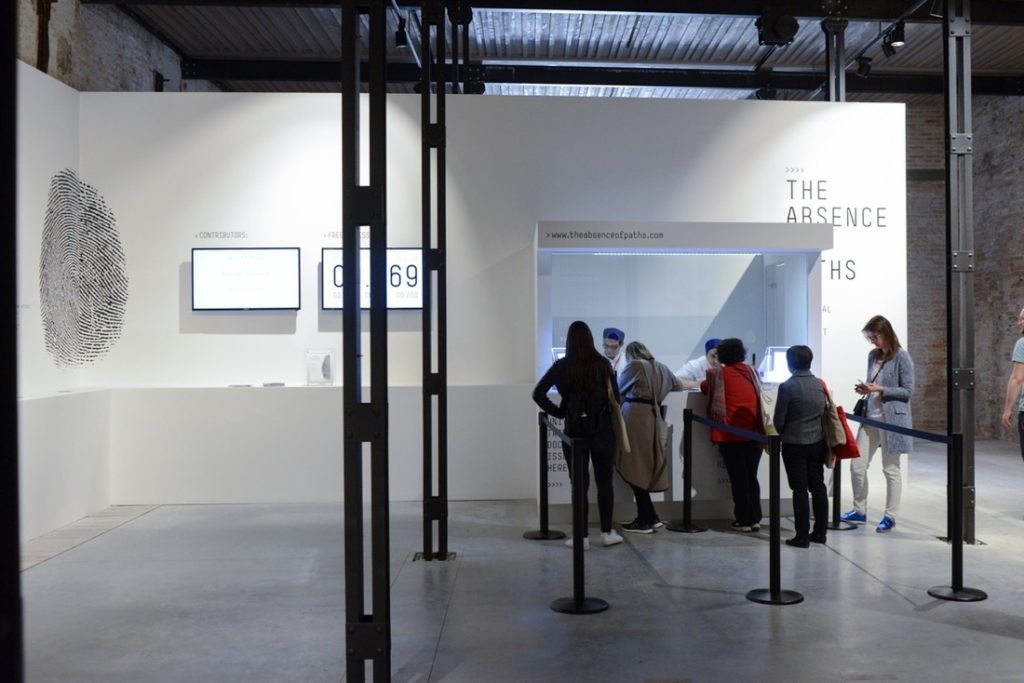
The Tunisian Pavillion in the Arsenale on May 10, 2017 the first preview day of the Venice Biennale in Venice, Italy. Photograph by Casey Kelbaugh, Photo on artsy.com
Reading materials:
- Quijano Coloniality and Modernity-Rationality
- Parashar – Feminism and Postcolonialism – Engendering Encounters
- Vazquez and Mignolo – Decolonial AestheSis- Colonial Wounds-Decolonial Healings
Supplementary Reading:
- Audre Lorde – The Master’s Tools Will Never Dismantle The Master’s House
- Irmgard Emmelhainz: Geopolitics and Contemporary Art, Part I: From Representation’s Ruin to Salvaging the Real
- Rijin Sahakian: What We Are Fighting For
Links:
- Readings from Postcolonial Studies special issue: Feminism Meets Postcolonialism from 2016
- Reading from Translating the Queer: Body Politics and Transnational Conversations (attachment forthcoming)
Chandra Talpade Mohanty (Interview):
Date: Monday 06.11.2017, 17 – 20:00
Address: Ex-club (Merimiehenkatu 36, 00150 Helsinki, Finland) Call 0417537605 to get in
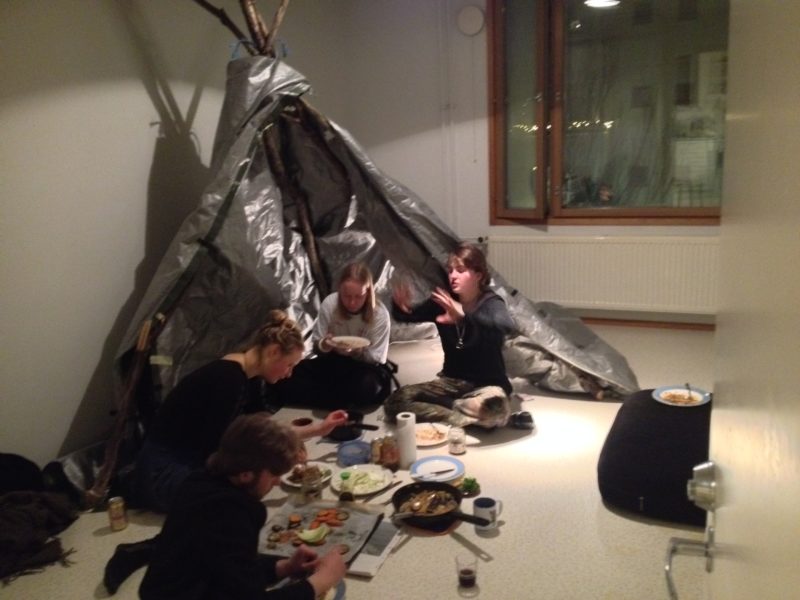
Photo: Reading group meeting at tipi inside student apartment, Helsinki. Fi
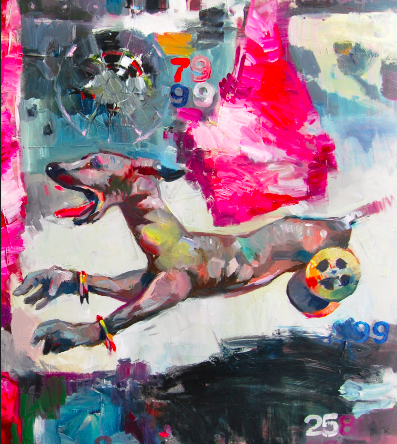
Image from “Suomi100 shadow-exhibition” curated by Heidi Hänninen at Galleria Kalleria (Kaarlenkatu 10, Kallio, Helsinki) Link
× × ×
× × ×
10.2017 #2
The next reading group meeting will be simultaneous with the Become Collective series talk by Giovanna Esposito Yussif & Christine Langinauer titled Practice Sharing Practice, and is followed by an informal conversation and dinner.
In the previous session, we discussed a review by the Indian scholar, postcolonial theorist and Feminist writer Gayatri Spivak on Vivek Chibber’s book Postcolonial Theory and Spectator of Capital. We also went over in chapter in Fanon’s The Wretched of the Earthtitled On National Culture. We mentioned Palestine as a good example of contemporary colonialism and Eyal Weizman’s piece on The Politics Of Verticality, and use of geographical landscape in special dominance and control.
Based on both Chibber and Spivak’s texts, we quickly reviewed post-colonial ideas by Edward Said, Gramsci, and Fanon in relation to contemporary post-colonial discourses taught in academy, and accessibility of these documents to the general public. Contemporary online-activism and inaccessibility of academic material can be juxtaposed to Aaron Swartz’s Jstor project which led to his mysterious death.
Ranabir Samaddar’s text was mentioned during the meeting, the text in which he uses the postcolonial lens to analyse issues of subjectivity, forced migration, and displacement. Samaddar has worked extensively on issues of migration and forced migration, nationalism and post-colonial statehood in South Asia, as well as new regimes of technological restructuring, labor control, and forms of labor. Samaddar gave a lecture titled Debt and Migration in the Postcolony. An Enquiry into Greece’s Crisis during the Documenta 14 in Athens.
Reading materials:
TBD
Supplementary Reading:
Fred Moten and Stefano Harney, The University and the Undercommons
Karl Marx’s Capital, Vol. 1, Chapter 15 (Sections 3-6)
Date: Tuesday 17.10.2017, 18:30 – 21:00
Address: Ex-club (Merimiehenkatu 36, 00150 Helsinki, Finland) Call 0417537605 to get in
× × ×
× × ×
10.2017 #1
The next meeting will focus on postcolonial ideas and subjectivity in relation to what Vivek Chibber calls the Specter of Capital. The book (Postcolonial Theory and the Specter of Capital) received enormous attention after its publication in 2013 and was supported by Chomsky and Zizek. However, the book criticizes postcolonial theory as represented by the Subaltern Studies school. Gayatri Spivak wrote a review of the book that was published in Cambridge Review of International Affairs to which Chibber replied in the same journal.
In the previous meeting, we focused on post 9-11 issues in the west especially in the United States in regard to gender with rising nationalism and homonationalism in LGTBIQ communities. In “Mapping US Homonormativities” Jasbir K. Puar focused on the harms that were caused by nationalism to these geographies. She concludes:
Aside from their work on “Selected Subaltern Studies” book, both Spivak and Chibber have worked on a critique of postcolonial theory from two different points (Spivak’s A Critique of Postcolonial Reason, and Chibber’s Postcolonial Theory and the Specter of Capital). Spivak has introduced the “strategic essentialism” a major concept in postcolonial theory.
Alex Anderson describes the book in a review published in Los Angeles Review of Books:
Subaltern Studies rose to prominence in the 1980s and was part of a wave of postcolonial critique of an ongoing essentializing gaze used when discussing formerly colonized cultures. Chibber formulates his critique of the critique (by way of Karl Marx) through the affirmation of Enlightenment universals. He argues that we are all endowed with reason and that this is not merely a “Western” construct. It was a book that he did not want to write, as he admits in the preface, believing that there was no space in “intellectual culture” for a “serious engagement with postcolonial theory.”
We read Ranabir Samaddar’s text in which he uses the postcolonial lens to analyse issues of subjectivity in regards to forced migration and displacement. He concludes that “rights are invisible, and we have to do what we can to recognize and protect the rights of the victims of forced migration.”
Reading materials:
Supplementary Reading:
Date: Friday 06.10.2017, 19:00 – 21:00
Address: Myymälä2 Gallery, (Uudenmaankatu 23, 00120 Helsinki, Call 0417537605 to get in)
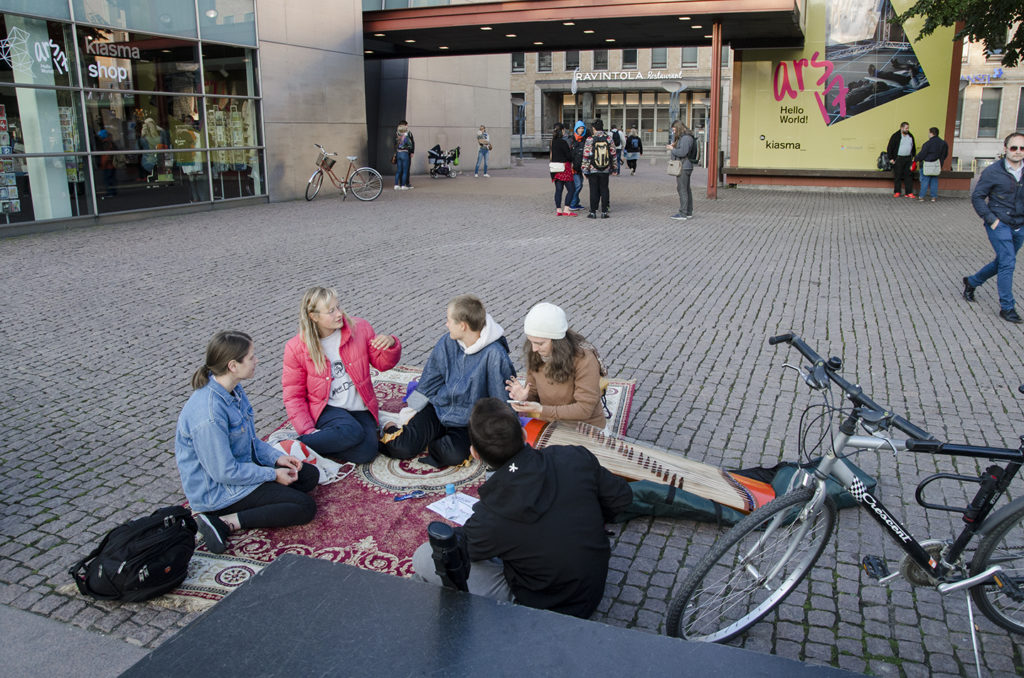
Reading group meeting 01.09.2017
× × ×
× × ×
09.2017 #2
Approaching the 16th anniversary of September-11 attacks, the next meeting will focus on postcolonial ideas and subjectivity in relation to what Vivek Chibber calls the Specter of Capital. The book (Postcolonial Theory and the Specter of Capital) received enormous attention after its publication in 2013 and was supported by Chomsky and Zizek. However, the book criticizes postcolonial theory as represented by the Subaltern Studies school. Gayatri Spivak wrote a review of the book that was published in Cambridge Review of International Affairs to which Chibber replied in the same journal.
In the previous meeting, we focused on post 9-11 issues in the west especially in the United States in regard to gender with rising nationalism and homonationalism in LGTBIQ communities. In “Mapping US Homonormativities” Jasbir K. Puar focused on the harms that were caused by nationalism to these geographies. She concludes:
Aside from their work on “Selected Subaltern Studies” book, both Spivak and Chibber have worked on a critique of postcolonial theory from two different points (Spivak’s A Critique of Postcolonial Reason, and Chibber’s Postcolonial Theory and the Specter of Capital). Spivak has introduced the “strategic essentialism” a major concept in postcolonial theory that minority groups use as a political strategy to represent themselves in different contexts.
Alex Anderson describes the book in a review published in Los Angeles Review of Books:
Subaltern Studies rose to prominence in the 1980s and was part of a wave of postcolonial critique of an ongoing essentializing gaze used when discussing formerly colonized cultures. Chibber formulates his critique of the critique (by way of Karl Marx) through the affirmation of Enlightenment universals. He argues that we are all endowed with reason and that this is not merely a “Western” construct. It was a book that he did not want to write, as he admits in the preface, believing that there was no space in “intellectual culture” for a “serious engagement with postcolonial theory.”

“Day 156” Photo by Right to Live demo, Helsinki
Also as supplementary reading will read Ranabir Samaddar’s text in which he uses the postcolonial lens to analyse issues of subjectivity in regards to forced migration and displacement. He concludes that “rights are invisible, and we have to do what we can to recognize and protect the rights of the victims of forced migration.”
Reading materials:
- Vivek Chibber, Postcolonial Theory and the Specter of Capital (Chapter 1)
Supplementary Reading:
- Spivak’s review
- Ranabir Samaddar, Forced Migration: State of the Field
- Karl Marx’s Capital, Vol. 1, Chapter 14
Link to Download
Date: Monday 18.09.2017, 20:00 – 21:30
Address: Ex-club (Merimiehenkatu 36, 00150 Helsinki, Finland) Call 0417537605 to get in
× × ×
× × ×
09.2017 #1
Following Eva Cherniavsky’s Neocitizenship, we are moving to alternative approaches to resistance and performing our everyday lives. We ended the conversation last time about the community of artists who are interested to resist the neoliberal hegemony and its ideology. After this week’s news from Charlottesville (Link) and Turku (attacks to refugees), we see that there is an immediate need to become collective in questions regarding action.
Following the concept of poverty of philosophy and Arendt’s vita contemplativa, this time we focus on the notion of subjectivity, performative identities and recognizing the problematics.
“So philosophy has to “run after” all sorts of new discourses, such as women, postcolonial subjects, the audiovisual media, and other new technologies, etc., in order to incorporate them into its way of thinking; in this respect philosophy is logophobic. It is thus doomed to accept processes of becoming or to perish.” – Rosi Braidotti, Nomadic Theory
We focus on the same problem but this time from Judith Butler’s perspective in the reading of Hegel’s Lordship and Bondage (attached in the reading material). And nationalism (sometimes homo-nationalism) in relation to the body of the other through imaginative geographies of the US in an age of counter-terrorism. We can also see similar lines of thought in the critics of a sovereign state and the presence of the body of the other in “States of Injury” by Wendy Brown and Şeyla Benhabib’s “The Claims of Culture”.
“It is through imaginative geographies produced by homo-nationalism, for example, that the contradictions inherent in the idealization of the US as a properly multicultural heteronormative but nevertheless gay-friendly, tolerant, and sexually liberated society can remain in tension. This mapping or geography is imaginative because, despite the unevenness, massively evidenced, of sexual and racial tolerance across varied spaces and topographies of identity in the US, it nonetheless exists as a core belief system about liberal mores defined within and through the boundaries of the US.” -Jasbir K. Puar
“We should, I suppose, be very thankful to live in this rich region that the institutional foreclosures of the philosophic have produced: such good company and better wine, and so many more unexpected conversations across disciplines, such extraordinary movements of thought that surpass the barriers of departmentalization, posing a vital problem for those who remain behind. The bondsman scandalizes the lord, you will remember, by looking back at him, evincing a consciousness he or she is not supposed to have had, and so showing the lord that he has become Other to himself.” –Judith Butler, Undoing Gender

Photo from verso (Antifascists in Charlottesville, August 12. via It’s Going Down.)
Reading materials:
- Jasbir K. Puar, Mapping US Homonormativities (essay)
Supplementary Reading:
- Asad Haider, Those Who Refuse
- Judith Butler – Can the “Other” of Philosophy Speak?
- Karl Marx’s Capital, Vol. 1, Chapter 13
Link to Download
Date: Friday 01.09.2017, 18:00 – 20:00
Address: Meeting in front of Kiasma, Helsinki (Call 0417537605 if you get lost). After the reading, we will join other students in Ex-club for a get-together/casual dinner at ~20:00.
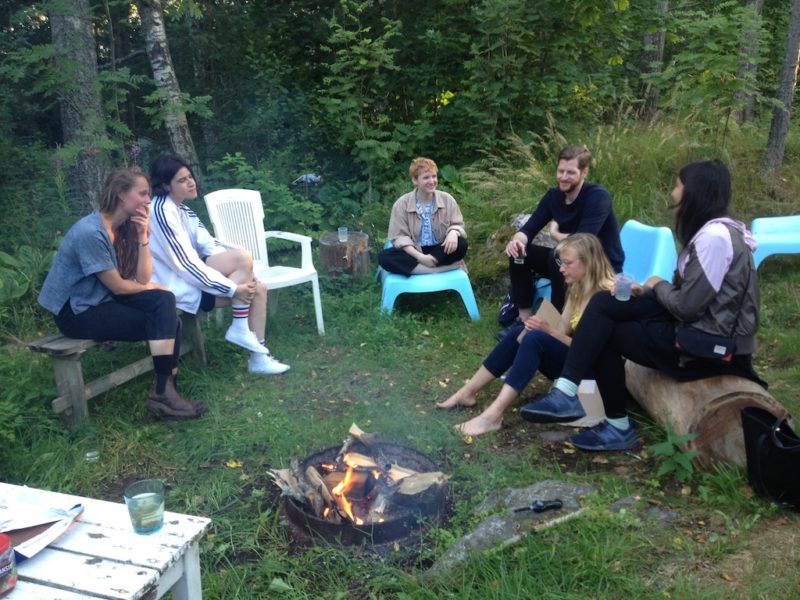
Image: Reading group meeting, Vartiosaari 11.08.2017
× × ×
× × ×
08.2017
HELSINKI:
In the previous session, we read Hannah Arendt in relation to public and private space and ideas around democracy and citizenship. We contrasted her ideas of vita activa(active life) and vita contemplativa (contemplative life), to the concept of poverty of philosophy introduced by Karl Marx, and the Greek notion of politics in public and private space, democracy, citizenship, and state.
Following Arendt’s idea of political life and human as a social animal, we will move to Eva Cherniavsky’s book Neocitizenship: Political Culture After Democracy. She describes the current state of citizenship with neoliberal hegemony as:
“…the complex of phenomena we generally describe as “neoliberalism” (state-subsidized market “freedoms” supporting an ever more comprehensive enclosure of the commons; the massive reorganization of public and private domains, including the outsourcing of state functions to private corporations and proliferating, non-state agencies of governance) proceeds in tandem with the eclipse of a disciplinary society, oriented toward the internalization of common sensibilities and foundational beliefs as the condition of civic belonging. Neoliberalism abandons the historical project of the bourgeois nation-state, in other words, that entailed norming mass political sentiment and cultivating broad identification with the aims of the ruling faction(s). ”
Following the conversation of contemporary migration, human movement, and precarity, we move past the classical argument of sovereignty of nation-state, and civic society in relation to neoliberalism. Cherniavsky describes this situation as following:
“…we may anticipate that neoliberalism displaces not only the nation-state synthesis, but also the particular articulation of sovereign to disciplinary power that this synthesis both provokes and enables. How readily such an analytic—wrought in the theoretical consideration of something called “the modern nation-state”—illuminates the situation of any specific (post)modern nation-state is a question about the reach of neoliberalism, the depth and speed to which it penetrates the nations and regions of the world, as well as the uneven interactions of neoliberal agents and policies with established and eroding local formations”
As supplementary reading this time, we will read on knot theory suggested by Jo Kjærgaard. “This text is a good introduction to knot theory, but skip the introduction and start by page 8. I suggest reading chapter 1 or at least half of it, it becomes more technical around page 16, but that can be read through.” – Jo

Reading materials:
- Eva Cherniavsky – Neocitizenship: Political Culture After Democracy (chapter II, or as much as you can)
Supplementary Reading:
- Kunio Murasugi – Knot Theory and Its Applications
- Karl Marx’s Capital, Vol. 1, Chapter 11 & 12
Link to Download
Date: Friday 11.08.2017, 18:00 – 21:00
[Helsinki] Address: Meeting at Reposalmentie 2, 00840 Helsinki, (to take the boat to Vartiosaari, Call 0417537605 if you get lost)
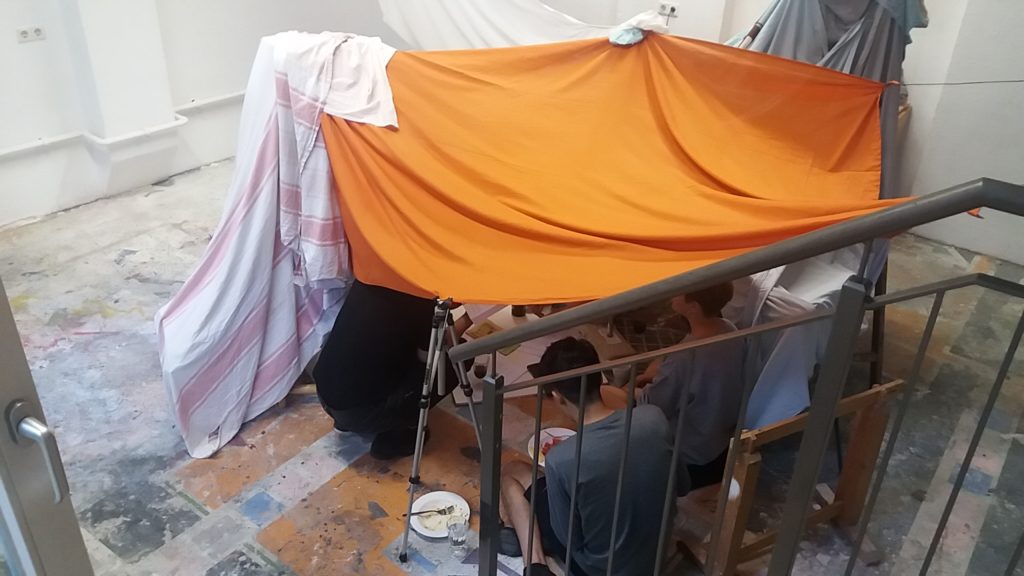
Image: Reading Group, Berlin 23.07.2017
× × ×
× × ×
07.2017 #2
HELSINKI:
In the previous session, we read Hannah Arendt in relation to public and private space and ideas around democracy and citizenship. We contrasted her ideas of vita activa (active life) and vita contemplativa (contemplative life), to the concept of poverty of philosophy introduce by Karl Marx, and the Greek notion of politics in public and private space, democracy, citizenship and state.
Following Arendt’s idea of political life and human as a social animal, we will move to Eva Cherniavsky’s book Neocitizenship: Political Culture After Democracy. She describes the current state of citizenship with neoliberal hegemony as:
“…the complex of phenomena we generally describe as “neoliberalism” (state-subsidized market “freedoms” supporting an ever more comprehensive enclosure of the commons; the massive reorganization of public and private domains, including the outsourcing of state functions to private corporations and proliferating, non-state agencies of governance) proceeds in tandem with the eclipse of a disciplinary society, oriented toward the internalization of common sensibilities and foundational beliefs as the condition of civic belonging. Neoliberalism abandons the historical project of the bourgeois nation-state, in other words, that entailed norming mass political sentiment and cultivating broad identification with the aims of the ruling faction(s). ”
Following the conversation of contemporary migration, human movement and precarity, we move pass the classical argument of sovereignty of nation-state, and civic society in relation to neoliberalism. Cherniavsky describes this situation as following:
“…we may anticipate that neoliberalism displaces not only the nation-state synthesis, but also the particular articulation of sovereign to disciplinary power that this synthesis both provokes and enables. How readily such an analytic—wrought in the theoretical consideration of something called “the modern nation-state”—illuminates the situation of any specific (post)modern nation-state is a question about the reach of neoliberalism, the depth and speed to which it penetrates the nations and regions of the world, as well as the uneven interactions of neoliberal agents and policies with established and eroding local formations”
Reading materials:
- Eva Cherniavsky – Neocitizenship: Political Culture After Democracy (Introduction + chapter I)
Supplementary Reading:
- Sara Ahmed – A phenomenology of whiteness (Essay)
- Karl Marx’s Capital, Vol. 1, Chapter 10
Link to Download
Date: Friday 28.07.2017, 19:00 – 21:00
[Helsinki] Address: Ex-club (Merimiehenkatu 36, 00150 Helsinki, Finland) Call 0417537605 to get in
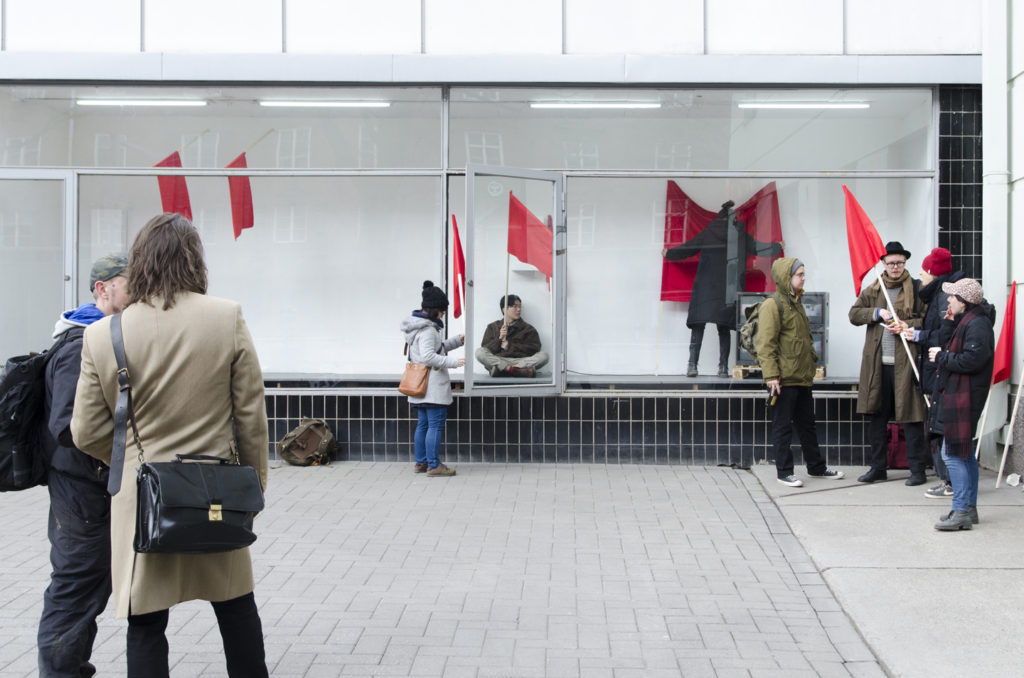
Photo from Red May exhibition in Helsinki
––
BERLIN:
Gathering and conversation.
Date: Sunday 23.07.2017, 18:00 – 21:00
[Berlin] Address: Kuva Residency, (Brunnenstraße 45, 10115 Berlin)
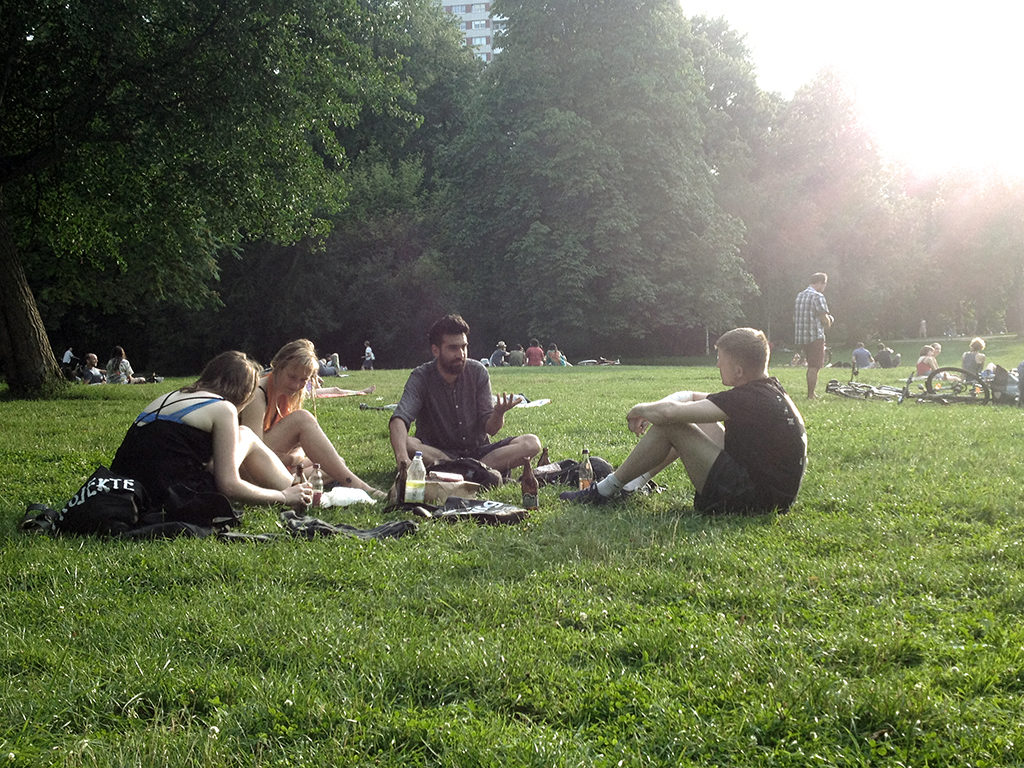
Photo from the pop-up reading conversation, Berlin
× × ×
× × ×
07.2017
The conversation will be at “Memory of War” exhibition:
Arendt presents the problem of public and private space in the 2nd Chapter of The Human Condition. We will be studying this concept in relation to education outside or within the walls of the institution. After reading Shahram Khosravi’s text ‘Illegal’ Traveller: An Auto-Ethnography of Borders, and Edward Said’s Orientalism and discussing cultural identity, issue of representation in regards to power, Marxist philosophy and production of knowledge, we are moving to Arendt’s ideas presented in Human Condition, Arendt’s vita activa (active life) and vita contemplativa (contemplative life), her philosophical notion of labor and work. The vita activa may be divided into three sorts of activities: labor, work and action. The problems Arendt identified are things such as diminishing human agency and political freedom.
“Exasperation with the threefold frustration of action — the unpredictability of its outcome, the irreversibility of the process, and the anonymity of its authors — is almost as old as recorded history. It has always been a great temptation, for men of action no less than for men of thought, to find a substitute for action in the hope that the realm of human affairs may escape the haphazardness and moral irresponsibility inherent in a plurality of agents.”
In one part, through analyzing the vita activa, she comes across ideas about automation and machines which is worth thinking about in contrast to contemporary technological developments, theoretical discourses on transitional modes of production, and the status of work in today’s post-communist era with the neoliberal hegemony.
As supplementary reading, we will also go over the ideas on political struggles of refugees in post 9.11 era, by Laura Pulido a Chicana activist and theoretician with her text A Day Without Immigrants.
Reading:
- Hannah Arendt – “The Human Condition” (Chapter II. part 4 – 7, until page 50)
Supplementary Reading:
- Laura Pulido – A Day Without Immigrants: The Racial and Class Politics of Immigrant Exclusion
- Gert Biesta – Making Pedagogy Public: For the Public, of the Public, or in the Interest of Publicness?
- Karl Marx’s Capital, Vol. 1, Chapter 7 – 9 (to the end of chapter 9)
Link to Download
Date: Wednesday 12.07.2017, 17:30 – 19:30
Address: Memory of War exhibition at Kaapeli
––
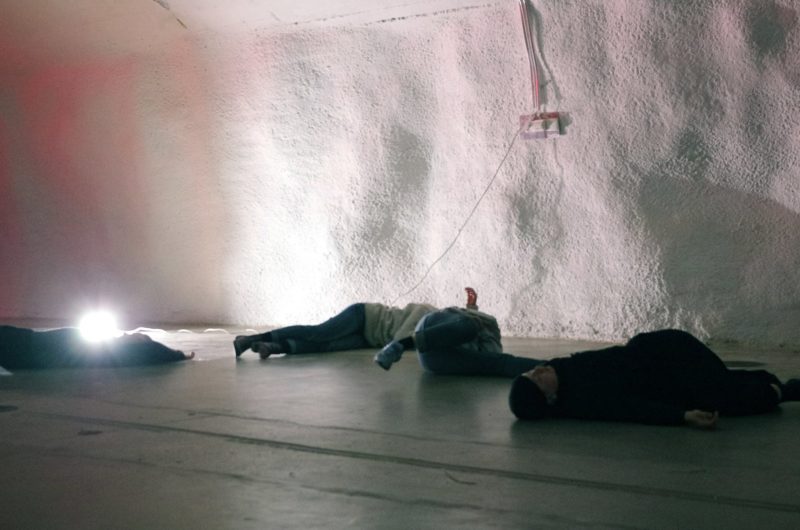
Photo from Stop Deportation Festival, Vapaantaiteentila, Helsinki May 2017
× × ×
× × ×
6.2017, #3
After reading Edward Said’s “Orientalism” and discussing cultural identity, issue of representation in regards to power, Marxist philosophy and production of knowledge, we are moving to Arendt’s ideas presented in Human Condition, Arendt’s vita activa (active life) and vita contemplativa (contemplative life), her philosophical notion of labor and work. The vita activa may be divided into three sorts of activities: labor, work and action. The problems Arendt identified are things such as diminishing human agency and political freedom.
“Exasperation with the threefold frustration of action — the unpredictability of its outcome, the irreversibility of the process, and the anonymity of its authors — is almost as old as recorded history. It has always been a great temptation, for men of action no less than for men of thought, to find a substitute for action in the hope that the realm of human affairs may escape the haphazardness and moral irresponsibility inherent in a plurality of agents.”
In one part, through analyzing the vita activa, she comes across ideas about automation and machines which is worth thinking about in contrast to contemporary technological developments, theoretical discourses on transitional modes of production, and the status of work in today’s post-communist era with the neoliberal hegemony.
As supplementary reading we will also read about biographical relationship of Hannah Arendt with Martin Heidegger.
- Hannah Arendt – “The Human Condition” (Introduction and prologue + part I; to page 21)
Supplementary Reading:
- Daniel Maier-Katkin and Birgit Maier-Katkin – Love and reconciliation: the case of Hannah Arendt and Martin Heidegger
- Norman Podhoretz – Hannah Arendt on Eichmann: A Study in the Perversity of Brilliance
- Karl Marx’s Capital, Vol. 1, Chapter 5 – 6 (to the end of chapter 6)
Link to Download
Date: Friday 30.06.2017, 19:00 – 21:00
Address: Ex-club (Merimiehenkatu 36, 00150 Helsinki, Finland) Call 0417537605 to get in
––
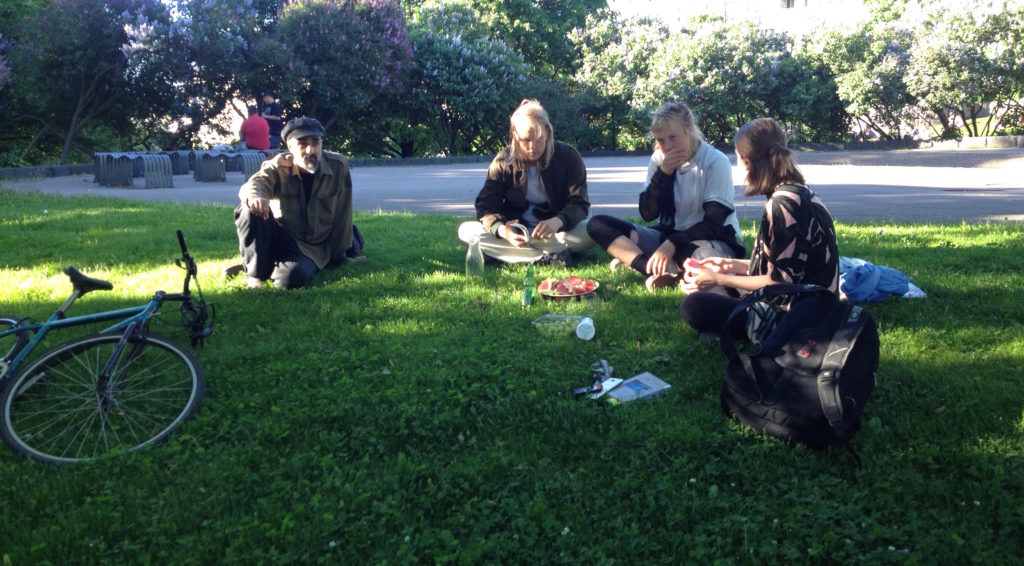
Photo from Reading group conversation, Helsinki
× × ×
× × ×
June 2017,
“The Orient and Islam have a kind of extrareal, phenomenologically reduced status that puts them out of reach of everyone except the Western expert. From the beginning of Western speculation about the Orient, the one thing the Orient could not do was to represent itself. Evidence of the Orient was credible only after it had passed through and been made firm by the refining fire of the Orientalist’s work.” -Orientalism by Edward Said
Edward Said surveys the history and nature of Western attitudes towards the East, considering Orientalism as a powerful European ideological creation – a way for writers, philosophers and colonial administrators to deal with the ‘otherness’ of Eastern culture, customs and beliefs.
In this work Said, presents that the idea of ‘Orient’ as a western invention in order to represent ‘middle east’. He creates a narrative in order to achieve a multicultural critique of power in relation to the contemporary struggles in middle east. He traces this view through the writings of Homer, Nerval and Flaubert, Disraeli and Kipling, whose imaginative depictions have greatly contributed to the West’s romantic and exotic picture of the Orient. In his new preface, Said examines the effect of continuing Western imperialism after recent events in Palestine, Afghanistan and Iraq. He beings the book by a quote from Marx;
“They cannot represent themselves; they must be represented.
—Karl Marx, The Eighteenth Brumaire of Louis Bonaparte”
In reading the book, we come across questions and issues around ‘representation’ and ‘misrepresentation’ which forces us to view the topic in relation to contemporary hegemony. As Said mentioned in the preface of the book (written in 2003), he has never taught anything about middle east in his academic career, although he was by training and practice a teacher of the mainly European and American humanities, and a specialist in modern comparative literature.
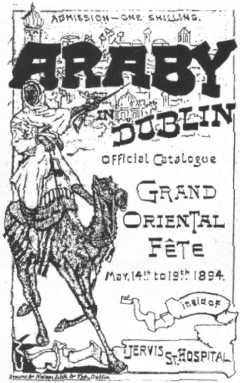
image from a cover poster of a funfair James Joyce’s short story Araby is based upon
Said is interested in the origins of the Western view of the Orient that shaped cultural knowledge of the Orient after 18th century. In his effort, the reader might learn a great deal about contemporary issues with existence of cultural domination of Europe and North America.
“I have found myself writing the history of a strange, secret sharer of Western anti-Semitism. That anti-Semitism and, as I have discussed it in its Islamic branch, Orientalism resemble each other very closely is a historical, cultural, and political truth that needs only to be mentioned to an Arab Palestinian for its irony to be perfectly understood. But what I should like also to have contributed here is a better understanding of the way cultural domination has operated. If this stimulates a new kind of dealing with the Orient, indeed if it eliminates the ‘Orient’ and ‘Occident’ altogether, then we shall have advanced a little in the process of what Raymond Williams has called the ‘unlearning’ of ‘the inherent dominative mode.'”
- Orientalism by Edward Said (preface & introduction – p.50)
Supplementary Reading:
DAS KAPITAL, Vol. 1, Chapter 3 + 4
Date: Monday 19.06.2017, 19:00 – 21:00
Address: Ex-club (Merimiehenkatu 36, 00150 Helsinki, Finland) Call 0417537605 to get in
––
× × ×
× × ×
May 2017, #2
Continuing with the Deleuzian Nomadology and Braidotti’s notion of the “other” and “becoming minor”, we are moving forward with a text from Shahram Khosravi, based on his book “The ‘illegal’ traveller”. In the last sessions, we have moved passed Thomas Nail’s Kinopolitics, theory of boarder and the notion of movement; “The history of the migrant is the history of social movement”. Thomas Nail draws from Marx’s concept of “Primitive Accumulation” and concludes that one of the two ways that social expulsion is possible, is territorial expansion that was possible on the condition that part of the population be expelled in form of migratory nomads, forced in surrounding mountains and deserts.
The ‘illegal’ traveller: an auto-ethnography of borders focuses on the rituals and performances of border crossing. This is a narrative of the late 20th century through the eyes of an ‘illegal’ migrant. Shahram Khosravi interjects his personal experiences into ethnographic writing. It is “a form of self-narrative that places the self within a social context”. Khosravi is the Professor of Anthropology at Stockholm University, and author of Precarious Lives: Waiting and Hope in Iran.
According to Khosravi, The vulnerability of border transgressors is best demonstrated by their animalisation. The terminology used in this field is full of names of animals to designate human smugglers and their clients; coyote for the human smuggler and pollos (chickens) for Mexican border crossers, shetou (snakehead) for Chinese human smugglers and renshe (human snakes) for smuggled Chinese. Iranians usually use the terms gosfand (sheep) or dar poste gosfand (in the skin of sheep) to refer to ‘illegal’ border crossers. Represented in terms of chicken and sheep – two animals traditionally sacrificed in rituals – the border transgressors are sacrificial creatures for the border ritual.…A zone of betwixt and between, a predicament of liminality is per se, in anthropological sense, a ritual. The border ritual reproduces the meaning and order of the state system. The border ritual is a secular and modern sort of divine sanctity with its own rite of sacrifice.
The border-regime exercises its power not only through ‘the right to live or die’, but pre-eminently through ‘the right to expose to death’. The border-regime exposes transgressive refugees/travellers to death through consigning them to ‘the zones of exemption where the sovereign power cease to function’.
The legal traveller passes the border gloriously and enhances his or her social status, whereas the border transgressor is seen as anti-aesthetic and anti-ethical (they are called ‘illegal’ and are criminalised). We live in an era of ‘world apartheid’, according to which the border differentiates between individuals.
- Shahram Khosravi, The ‘illegal’ traveller: an auto-ethnography of borders (essay)
Supplementary Reading:
DAS KAPITAL, Vol. 1, Chapter 1 + 2
Next meeting: June 2nd Friday, 19:00 – 21:00
Address: Ex-club (Merimiehenkatu 36, 00150 Helsinki, Finland) NOTE: Call 0417537605 to get in
––
× × ×
× × ×
May 2017
For this session, we will focus on “The Figure of the Migrant” by Thomas Nail, the book introduces us into political theory of an old phenomenon. The last decade alone has marked the highest number of migrations in recorded history. Constrained by environmental, economic, and political instability, scores of people are on the move. But other sorts of changes—from global tourism to undocumented labor—have led to the fact that to some extent, we are all becoming migrants. The migrant has become the political figure of our time.
Historically, there have been numerous figures of the migrant. For example, the nomad, the barbarian, the vagabond, and the proletariat are four major kinds of migratory figures. The figure of the migrant is not a class or identity; it is a vector (a position in motion). Migrants are the true movers of history and political transformation, but this does not mean their movements are immune from cooptation by states, capital, or other forms of expulsion. In fact, it is their captured motion that is the very condition of social power in the first place (slavery, serfdom, waged labor, and so on). –On Destroying What Destroys You: An Interview with Thomas Nail by Jose Rosales.
If we take the figure of the migrant as a primary or constitutive figure of politics, it requires more than a mere accommodation of this figure into the existing frameworks of liberalism, Marxism, multiculturalism, and so on. It requires a whole new theoretical starting point that does not begin with stasis and the state, but with the more primary social movements that constitute the state, as well as the social alternatives that arise from those same movements.
We have a chance to reflect upon Deleuzian Nomadology, Ethical and political concepts developed by Simon Critchley in “Infinitely Demanding: Ethics of Commitment, Politics of Resistance” and the Nomadic Theory of feminist philosopher Rosi Braidotti. Genevieve Lloyd discusses Rosi Braidotti’s rich concept of “nomadic subjectivity” in relation to current policies on the mass movements of asylum seekers and refugees, especially on “unauthorised” boat arrivals. It especially addresses Australian attitudes toward migration—past and present. The analysis discusses commonalities and differences between Braidotti’s critique of classical cosmopolitanism and Hannah Arendt’s treatment of universal human rights.
Thomas Nail is associate professor of philosophy at the University of Denver. His research is in European philosophy, Political philosophy, and Environmental philosophy. He works on recent European thought to contemporary political events like Zapatismo, migrant activism, the Occupy movement, and ecological resistance. His Latestest works are Theory of the Border and Returning to Revolution: Deleuze, Guattari and Zapatismo.
- The Figure of the Migrant by Thomas Nail
Part I and II (Political Theory of Migrant + Kinopolitics, until page 59)
Supplementary links:
Genevieve Lloyd – Nomadic Subjects and Asylum Seekers
Kathi Weeks – Life Within and Against Work: Affective Labor, Feminist Critique, and Post-Fordist Politics
Sianne Ngai – Our Aesthetic Categories
Link to Download
––
Next meeting: May 9th Tuesday, 18:30 – 21:00
Address: Myymälä2, Uudenmaankatu 23 F, Helsinki
Hosted by Golden Age of Chaos And Clusterfuck exhibition:
Conversation: “The Refugee in the Age of Fiber Optics”
Guests: Ayman Alshmary, Deyaa Almoosawy, Pyry Petra, Timo Tuhkanen, Tuukka Kaila, Dimitri Dombrowski, Jo Kjaergaard, Caspar Stracke, Lena Seraphin
Golden Age of Chaos And Clusterfuck is a collective effort of nine artists to understand, through art, the nature of knowledge in today’s society. When the processes through which we produce, reproduce, store and access information are changing, how does the society change as a result? Or rather, how do the changes in both effect each other? Consisting of field notes, observations, documentation and objects, the exhibition takes the form of a temporary research centre, in which the participating artists share their findings and source materials. The show will take shape organically as the artistic research continues in the gallery space. A publication documenting the process is produced on-site and launched at the end.

Photo by Tuukka Kaila, Poster of the “Golden Age of Chaos And Clusterfuck” exhibition on the floor.
× × ×
× × ×
APRIL 2017
For this session, we will focus of “The Figure of the Migrant” by Thomas Nail, the book introduces us into political theory of an old phenomenon. The last decade alone has marked the highest number of migrations in recorded history. Constrained by environmental, economic, and political instability, scores of people are on the move. But other sorts of changes—from global tourism to undocumented labor—have led to the fact that to some extent, we are all becoming migrants. The migrant has become the political figure of our time.
Historically, there have been numerous figures of the migrant. For example, the nomad, the barbarian, the vagabond, and the proletariat are four major kinds of migratory figures. The figure of the migrant is not a class or identity; it is a vector (a position in motion). Migrants are the true movers of history and political transformation, but this does not mean their movements are immune from cooptation by states, capital, or other forms of expulsion. In fact, it is their captured motion that is the very condition of social power in the first place (slavery, serfdom, waged labor, and so on). –On Destroying What Destroys You: An Interview with Thomas Nail by
If we take the figure of the migrant as a primary or constitutive figure of politics, it requires more than a mere accommodation of this figure into the existing frameworks of liberalism, Marxism, multiculturalism, and so on. It requires a whole new theoretical starting point that does not begin with stasis and the state, but with the more primary social movements that constitute the state, as well as the social alternatives that arise from those same movements.
We have a chance to reflect upon Deleuzian Nomadology, Ethical and political concepts developed by Simon Critchley in “Infinitely Demanding: Ethics of Commitment, Politics of Resistance” and the Nomadic Theory of feminist philosopher Rosi Braidotti.
Thomas Nail is Associate Professor of Philosophy at the University of Denver. His research is in European philosophy, Political philosophy, and Environmental philosophy. He works on recent European thought to contemporary political events like Zapatismo, migrant activism, the Occupy movement, and ecological resistance. His Latestest works are Theory of the Border and Returning to Revolution: Deleuze, Guattari and Zapatismo.
- The Figure of the Migrant by Thomas Nail
Part I and II (Political Theory of Migrant + Kinopolitics, until page 59)
× × ×
× × ×
MARCH 2017
For this session, we will do one more chapter of Lefebvre’s The Production of Space, titled: “From Absolute Space to Abstract Space”. We pair that with some parts of Donna Haraway’s When Species Meet.
In When Species Meet, Donna Haraway describes the rapport of a trainer with her dog as a model of how animal and human may be joined, almost as a single being, by bonds of shared purpose, understanding, and concern. In her view, the relationship between human beings and technologies is not one of exploitation but of mutual adaptation, and human beings and animals who work together intimately, in a bond that she calls one of “companion species,” therefore must also change one another. -Human and Post-Anima, by Boria Sax
“We Have Never Been Human,” contains a strong antidose against “human expectionalism,” the virus that severs the ties between humankind and all other kinds on the basis of some features unique to the former. Instead, Haraway invites us to see the human as just another knot in the worldwide web of interspecies dependencies, as always already in-formed by organic and technological nonhumans. The term she proposes for all these old, new, and yet-to-(be) come “mixed breeds” is “companion species,” offered as an alternative [End Page 309] category also to the cyborg and other figures currently subsumed under the label “posthuman” or, rather, as a new point of orientation from which to look at (and look back at—respectere, “to hold in regard”) animals and as a different way of theorizing relationality and co-presence with significant others of all types in twentieth-century naturecultures. -Manuela Rossini
- The Production of Space by Henri Lefebvre
Chapter 4 (From Absolute Space to Abstract Space) - When Species Meet by Donna Haraway’s
Introduction + Chapter 1&2, (until page 68)
Supplementary links:
Ihab Hassan, “Toward a Concept of Postmodernism” (From The Postmodern Turn, 1987)
Xenofeminism: A Politics for Alienation Laboria Cuboniks
In Katarzyna Piasecka’s terms, Xenofeminism movement is cut from the same cloth as #accelerationism – a futuristic theory announcing the end of capitalism and urging the political left to consolidate on a global level to bring about a post-capitalist future without work. The movement describe it as a technomaterialist, anti-naturalist, and gender abolitionist form of feminism.
After Testo Junkie by Paul B. Preciado, which in itself was a homage to French writer Guillaume Dustan, a close gay friend of Preciado’s who died of AIDS, “Xenofeminism is an affirmative creature on the offensive, fiercely insisting on the possibility of large-scale social change for all of our alien kin.”
Xenofeminism is a Politics for Alienation is a manifesto collectively penned by a group scattered across multiple timezones, working together under the pseudonym Laboria Cuboniks. Xenofeminism (XF) is a new feminism for a new reality that is defined by technological mediation and injected with – as LC writes in the manifesto’s opening – “abstraction, virtuality, and complexity.” The text hinges on an understanding that in the time since the millennium, the Internet itself has gone from a fresh-faced, hopeful youth to an embodiment of an angst-filled teenager. The overarching narrative of its patchwork of communities and ideologies might now be, “fuck off you’ll never understand.” – Aria Dean
× × ×
× × ×
FEBRUARY 2017
For this season, we are exploring the idea of interiority/exteriority, and the relation of the body and the surface. We are drawing from the political and phenomenological aspects of the works relevant to these issues; relationship of people to space (Palestine as an example), Henri Lefebvre’s dialectics in Marxism, everyday life, cities, and (social) space. readings and inserts:
1.” Settler-colonialist management of entrances to the native urban space in Palestine” by Emile Badarina
2. Chapter 2 of “The Production of Space” by Henri Lefebvre, titled “Social Space”
3. Introduction of the “Phenomenology of Perception” by Maurice Merleau-Ponty,
Link to download
Supplementary links:
http://www.notbored.org/space.html
http://www.e-flux.com/journal/64/60861/violence-at-the-threshold-of-detectability/
From Not Bored on Henry Lefebvre: “Thanks to an ever-expanding commodity economy, young people today look more rebellious, less socialized, and less like each other in matters of personal appearance than ever before. Piercings and tattoos are a clear sign that certain forms of social conformity and homogenization are at an end. And yet, Lefebvre (following Wilhelm Reich) wants to know, “Why do they allow themselves to be manipulated in ways so damaging to their spaces and their daily life without embarking on massive revolts?” An even better question: “Why is protest left to ‘enlightened,’ and hence elite, groups who are in any case largely exempt from these manipulations?’”
From Chomsky’s recent interview by “C.J. Polychroniou, Truthout”: …the so-called American Dream was always based partly in myth and partly in reality. From the early 19th century onward and up until fairly recently, working-class people, including immigrants, had expectations that their lives would improve in American society through hard work. And that was partly true, although it did not apply for the most part to African Americans and women until much later. This no longer seems to be the case. Stagnating incomes, declining living standards, outrageous student debt levels, and hard-to-come-by decent-paying jobs have created a sense of hopelessness among many Americans, who are beginning to look with certain nostalgia toward the past. This explains, to a great extent, the rise of the likes of Donald Trump and the appeal among the youth of the political message of someone like Bernie Sanders.
––
Next meeting: February 17th Friday, 19:00 – 21:00
Address: Ex-club (Merimiehenkatu 36, 00150 Helsinki, Finland) NOTE: Call 0417537605 to get in
––
dismightnotwork@gmail.com
If you would like to join, just come in, (free and open to all)
✳︎ ✳︎ ✳︎
We are open to collaboration and joint projects. The reading conversations are usually carried on collectively. The topic of each month’s reading varies based on the collective interest. We are reading books, essays and materials in topics regarding contemporary art studies, politics, philosophy, criticism, etc.
